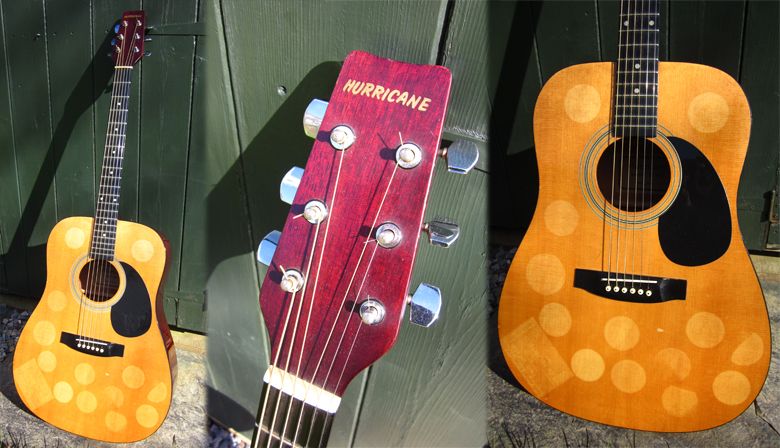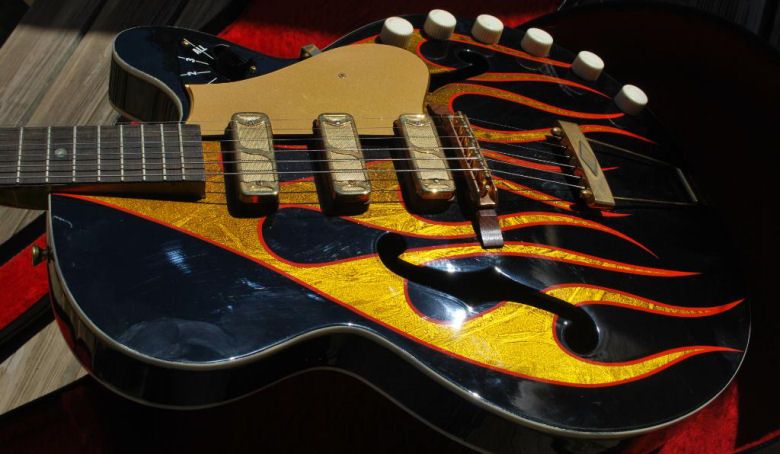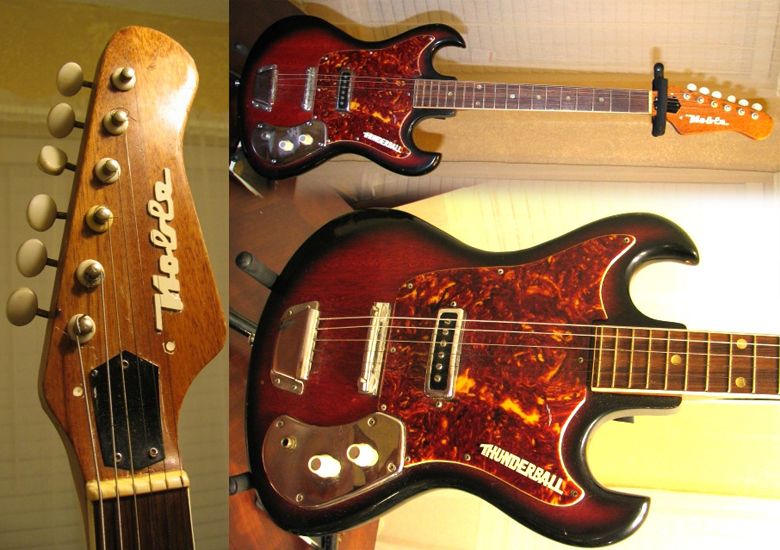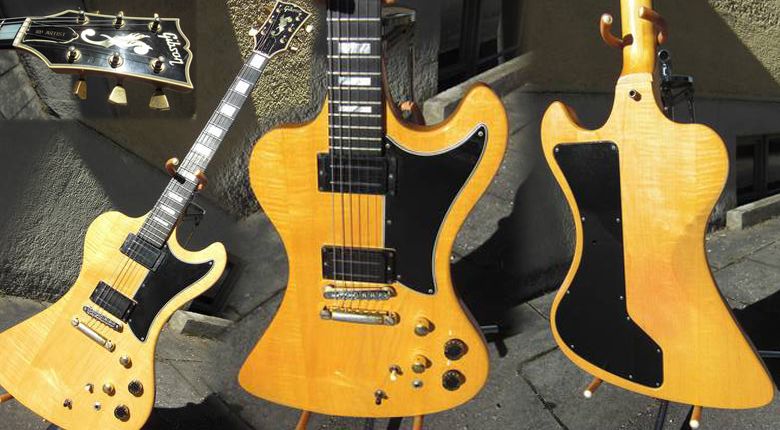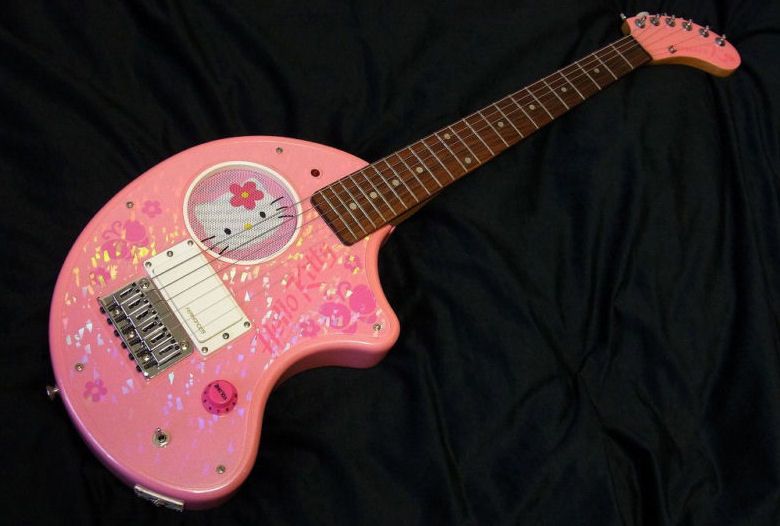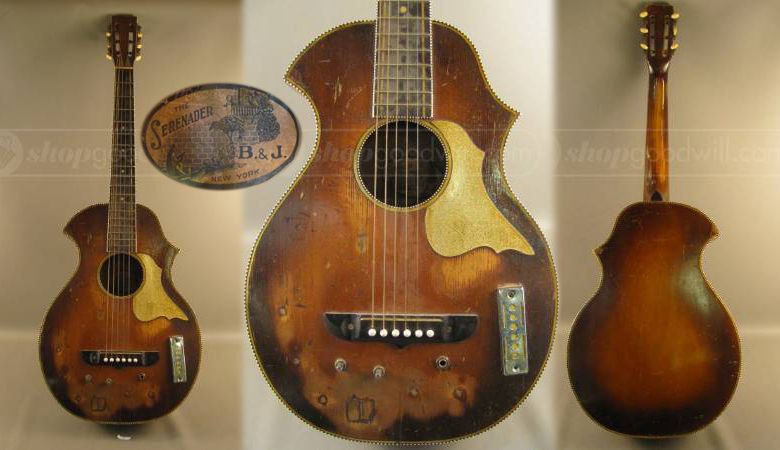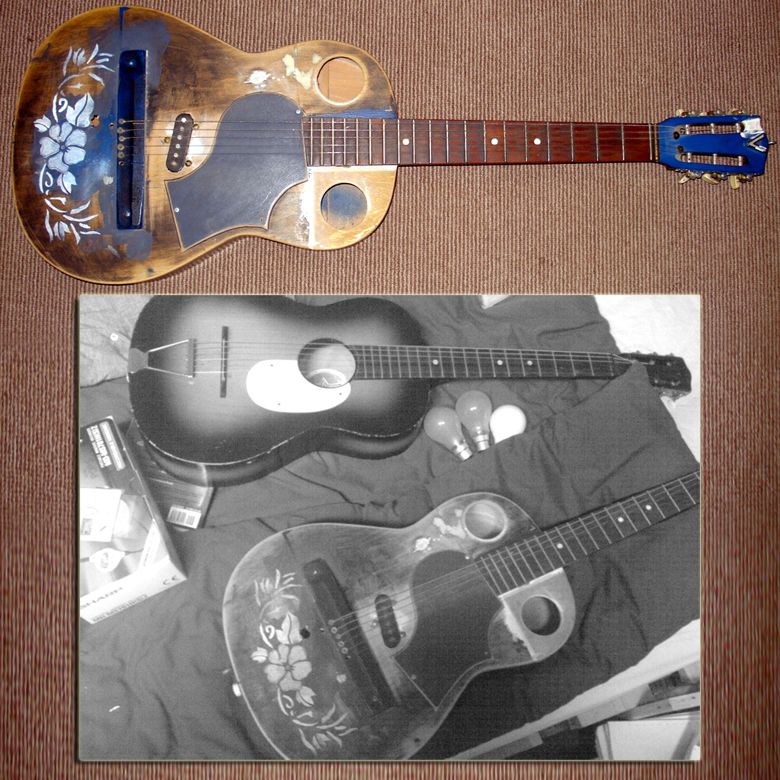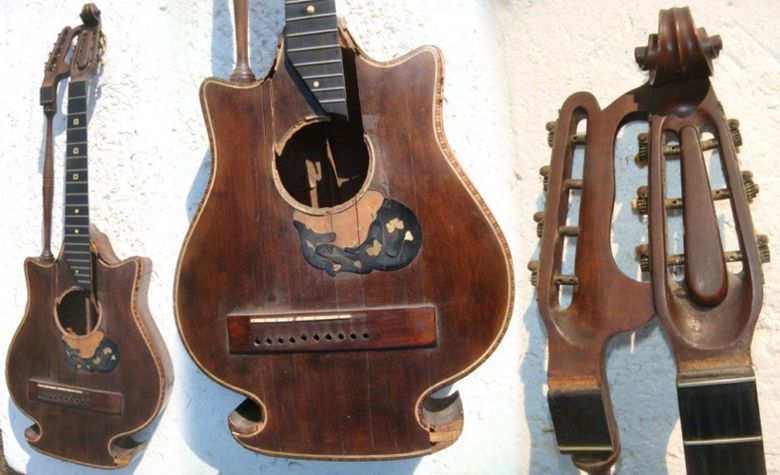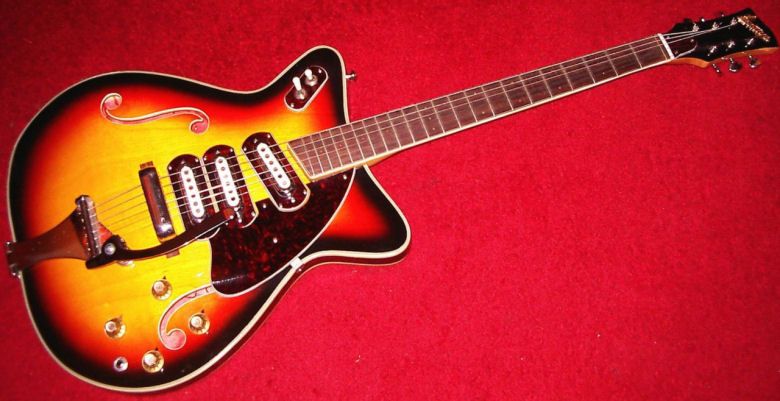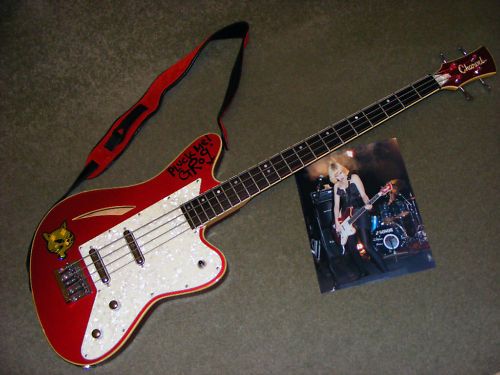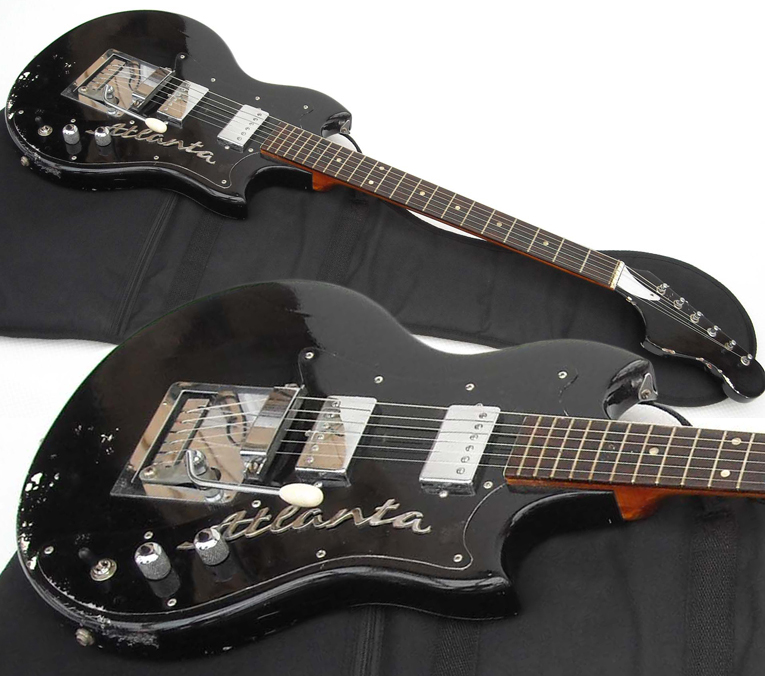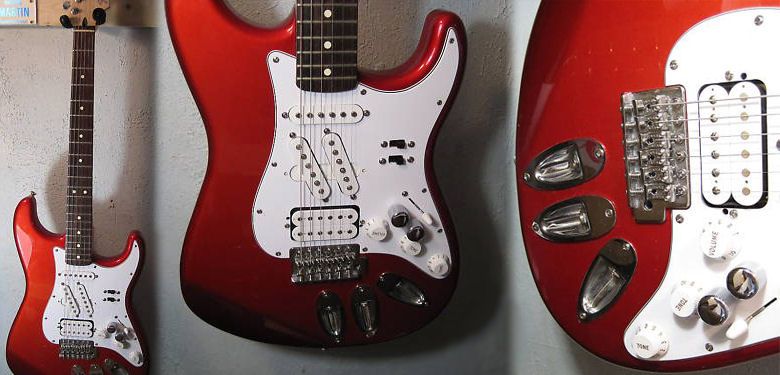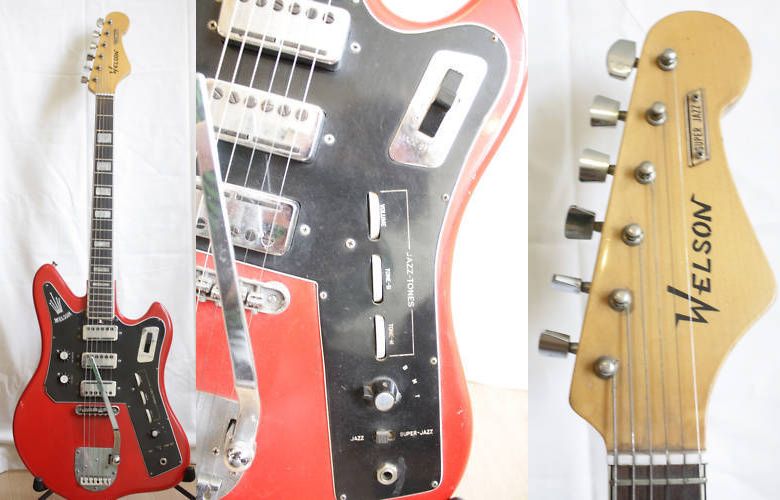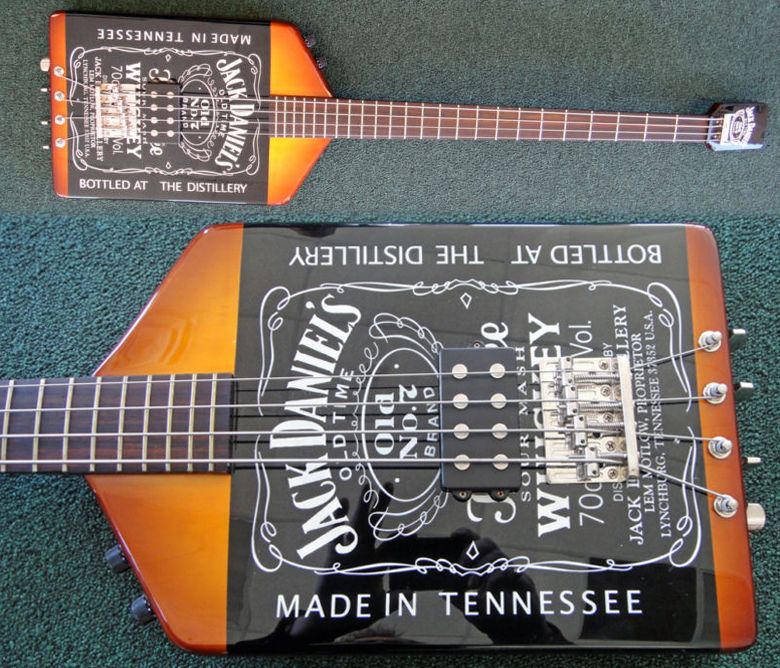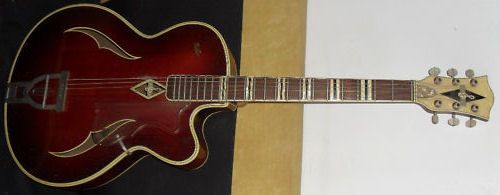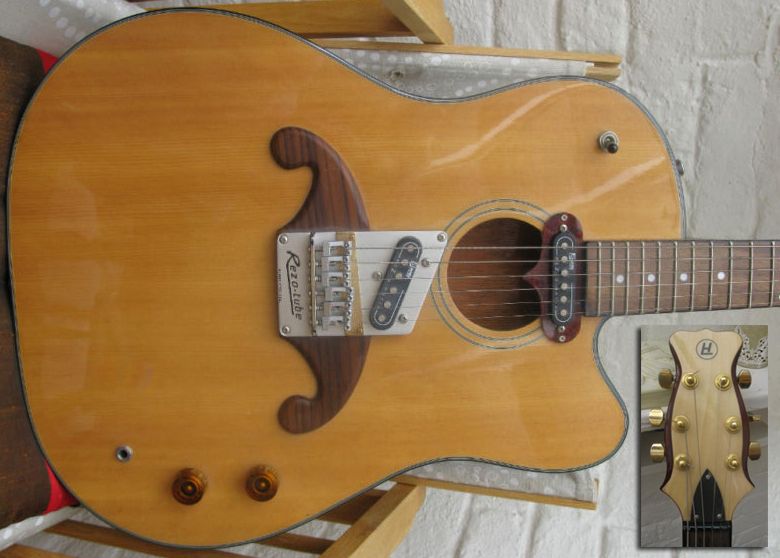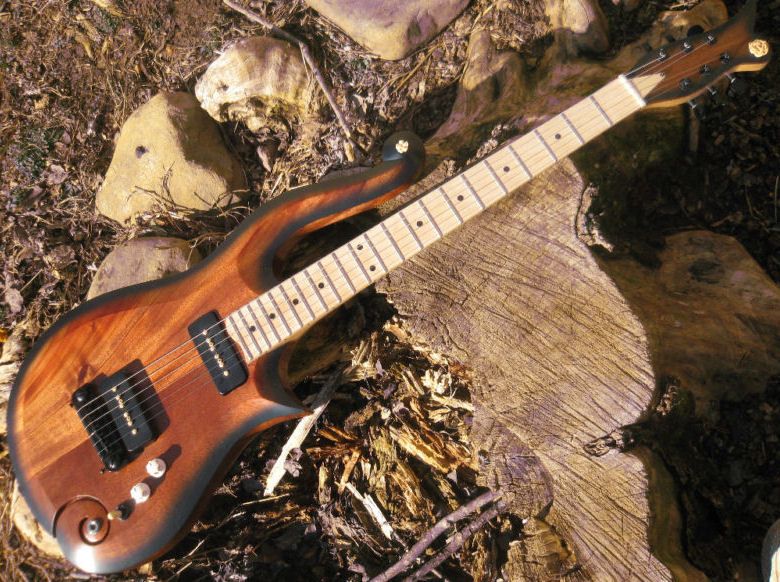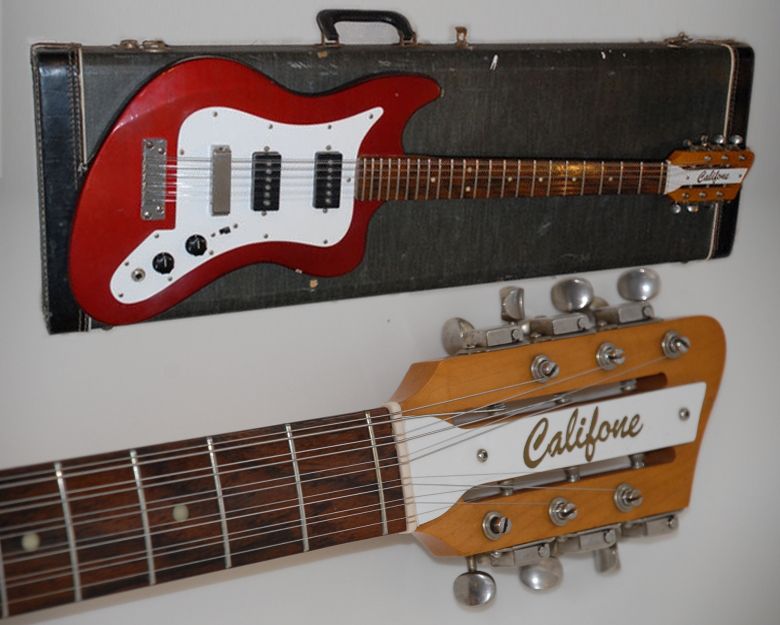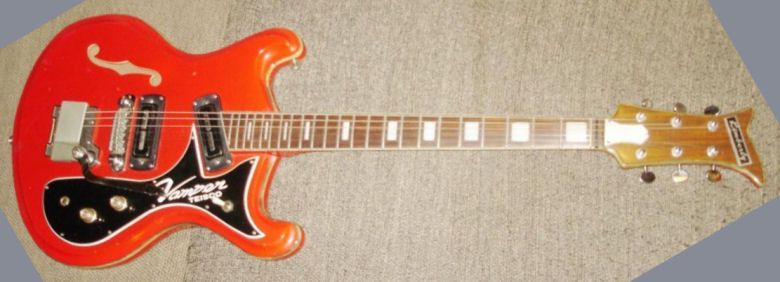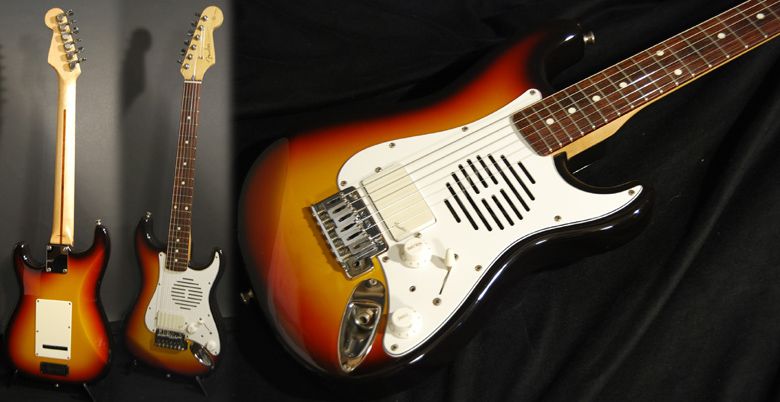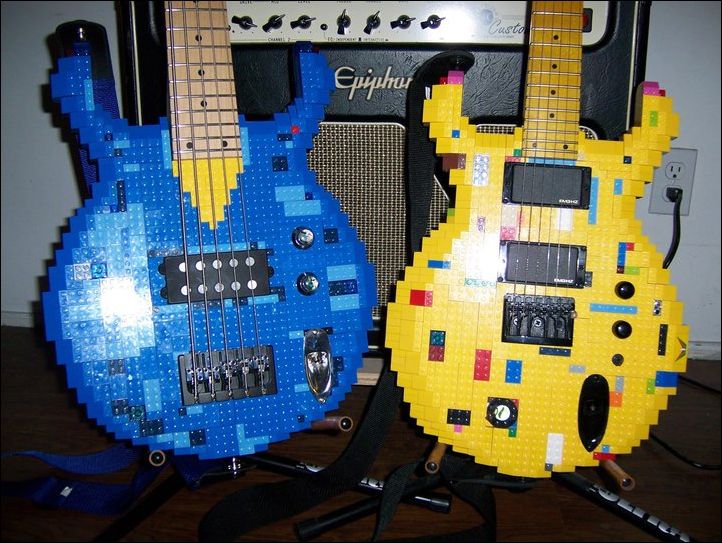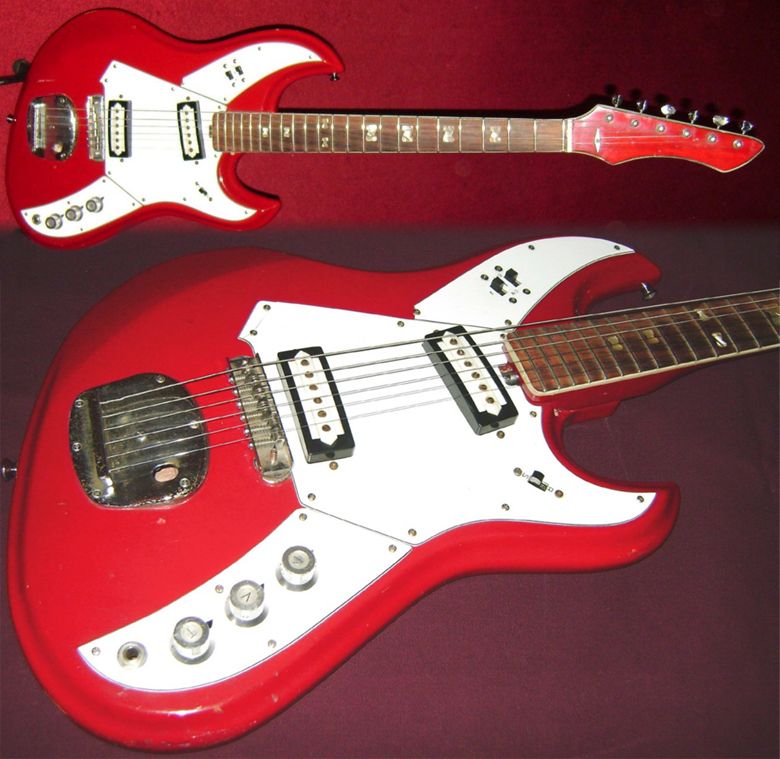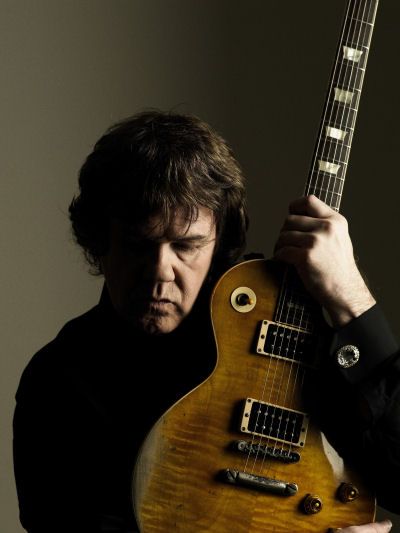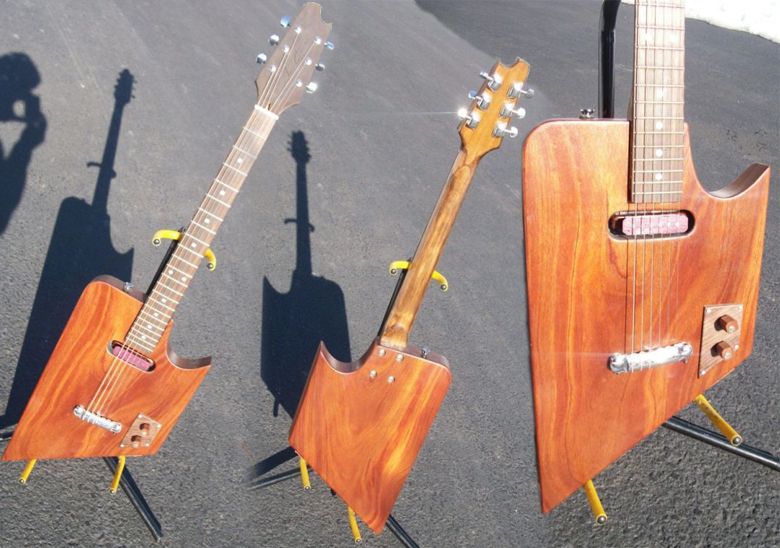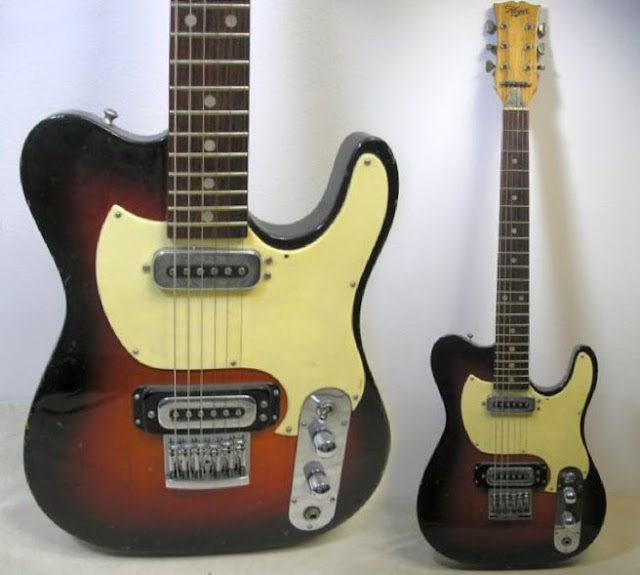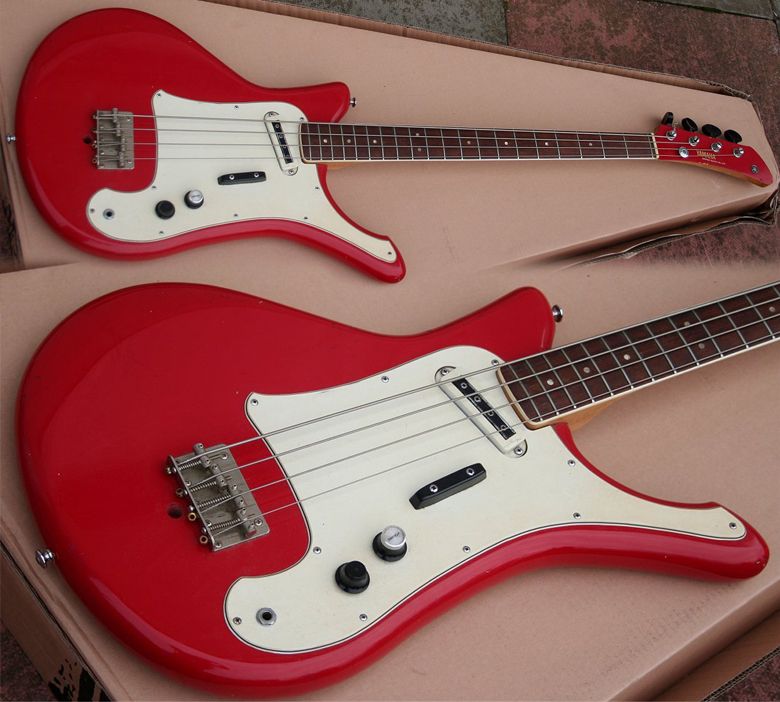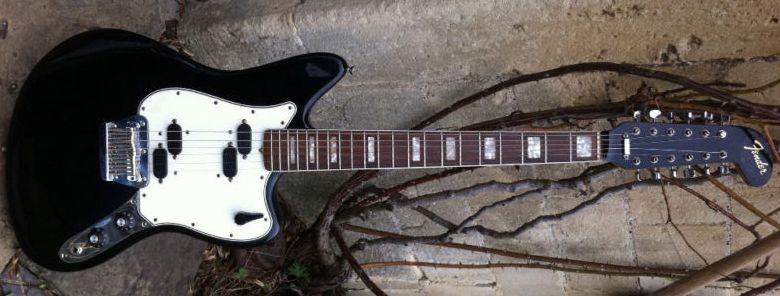guitarz.blogspot.com:
These photos illustrate quite nicely the evil presented by stickers and why they should never be allowed to sully a guitar's appearance. This guitar had its stickers removed after many years and whilst the uncovered finish of the guitar's top had changed to a more golden colour with age, the area beneath the stickers has remained the original colour.
Actually, this is my guitar. I bought it in this condition last week, and despite the above little rant I really am not bothered by its appearance. In a way, it adds character, but more to the point I really don't care because I got an absolute bargain here. It only cost me £20 (OK, call it £30 with post and packing). I don't think anyone else was bidding because of the appearance of the guitar. But, it's a really nice player (much better than my Ovation "thing" with the horrible action and which set me back between £300-£400 a few years back). I can't tell you how pleased I am with this guitar.
But... Has anyone heard of Hurricane guitars? The name sounds familiar, but I can't find out anything much about them. Apparently they made a few of the usual Fender and Gibson solidbody knock-offs. This acoustic was made in Japan - the seller reckoned 1970s but I tend to think 1980s is more likely - and the label inside the soundhole tells us that it's the Model BF-402. It's quite obviously a Martin copy, but its not a top of the range guitar. Witness the simple black binding on the body and total lack of neck binding. The tuners are also of the open-back type, although they function perfectly competently. The Hurricane logo is a quite a simple affair, if you could even call it a logo. It's just the name set in a particular font, and with the individual characters at different heights it looks as if it was designed using LetraSet letters (who remembers LetraSet? They were sheets of transfers that you had to apply to a surface by rubbing and peeling away the backing sheet).
So, anyway, the lesson is keep checking those auctions, and try to see beyond initial appearances.
G L Wilson
Guitarz - The Original Guitar Blog - now in its 10th year!
Monday, 28 February 2011
Harmony H59 Rocket in Hotrod finish
guitarz.blogspot.com:
I think I've gone on record before as saying I am not a fan of pin-striping, hotrod finishes and all that kind of thing, but - cliché or not - on this Harmony H59 Rocket I simply cannot deny that it looks fantastic. I'm going to borrow from the eBay listing and allow the seller to tell you about it:
Thanks to Julian Woods for pointing this one out.
G L Wilson
Guitarz - The Original Guitar Blog - now in its 10th year!
I think I've gone on record before as saying I am not a fan of pin-striping, hotrod finishes and all that kind of thing, but - cliché or not - on this Harmony H59 Rocket I simply cannot deny that it looks fantastic. I'm going to borrow from the eBay listing and allow the seller to tell you about it:
This is a unique opportunity to own an amazing completely redone Harmony Rocket. I purchased this from an avid collector who loved rockabilly music and hot rods. He took his favorite vintage rocket and had it “hot rodded”. He had his luthier overhaul everything. He redressed the frets, he replaced the floating wooden bridge with a modern roller bridge, he replaced the original tuners with a set of Grovers and readjusted everything to maximize playability. To complete his rockabilly/hot rod project he sent the guitar a custom bike shop in California to paint an amazing professional hot rod flame job paint on the body. The paint metallic paint just leaps out and in the light and looks incredible. The back of the neck is super smooth and plays like butter. Overall the guitar plays and sounds phenomenal! This is easily the best playing Harmony or Silvertone I’ve ever encountered.It just screams "Rockabilly" at you, doesn't it? (I have to admit that I do hate that expression "plays like butter". That seems to be one of those eBay guitar listing clichés. For me, it just conjures up an image of a really digustingly greasy guitar.)
The guitar’s neck is very comfortable and is shaped like a 59’ roundback, it isn’t super large like the old Silvertone archtops and it isn’t skinny either…just nice and meaty. There are no dead spots on the neck and no buzzing along the board. The frets are vintage and are shaped like the thin/wide vintage Gibson style. The famous Dearmond gold foil pickups sound big and bold clean and thick and juicy when overdriven. All the tone/volume knobs work and are not scratchy, however two of them don’t turn as easily as the others. They still turn just fine but just not as freely as the others. The pickup selector works and feels very solid. The guitar stays in tune like a dream. Overall an incredible instrument that is perfect for the studio or the stage.
To my knowledge everything is original except for the paint finish, the headstock decal, the replaced tuners, the replaced bridge, and the matching pick gold pickguard. The guitar is in very good condition, all the binding is very tight with no cracking. No major dings, scratches or blemishes...
Thanks to Julian Woods for pointing this one out.
G L Wilson
Guitarz - The Original Guitar Blog - now in its 10th year!
Sunday, 27 February 2011
1960s Klira with cool gear
Usually I would not have posted about this 1960s Klira because I didn't find a photo of the whole guitar, but actually I mostly wanted to focus on the gear - particularly the tremelo!
I know I told this many times but I really love these old German trems - it seems that each company did create a new one for each model - this is quite different nowadays!
This very vintage hollow body guitar has other cool stuff - the mini-humbuckers, the rotating switch... It's a pity that the top is warped and sagging, I wonder if it's fixable...
Bertram
Guitarz - The Original Guitar Blog - now in its 10th year!
Friday, 25 February 2011
Another mystery guitar needs identifying
guitarz.blogspot.com:
Here's an email from Jack:
G L Wilson
EDIT: It's a Roberts Iris and the band are called JetKing. Thanks to Bid Red X for that info!
Guitarz - The Original Guitar Blog - now in its 10th year!
Here's an email from Jack:
Thanks for the praise, but I don't think I'm going to come up trumps in this case. This is a design that I feel I should know and am sure I have seen somewhere before, but unfortunately I cannot put a name to it. If any of our readers can help, please tell us what you know via the comments.Hi Gavin
I've been an avid follower of your blog for a few years now and I have always admired your ability to identify random guitars!
Attached is a pic I took at a gig in Bristol earlier this week. It was the support band for Morning Parade and the guitar was seriously unusual.
Don't know if its that obvious from my (very bad) pic but the guitar had slanted lipstick pickups on humbucker sized plates, an old varitone switch on it and what looked like a small pushbutton switch, in addition to a pickup selector and volume. Tune-o-matic and then through body stringing. Unusual finish too. Not sure if it was modern or vintage... not a lot of help I know! I couldn't read what it said on the headstock, annoyingly!
I think the support band was called Jet something but I didn't quite catch it. Probably not a lot of use but you never know, someone may know what it was. It sounded awesome, by the way!
Thanks for any help you can give.
Jack Floyd
G L Wilson
EDIT: It's a Roberts Iris and the band are called JetKing. Thanks to Bid Red X for that info!
Guitarz - The Original Guitar Blog - now in its 10th year!
Thursday, 24 February 2011
1960s Japanese Noble Thunderball
guitarz.blogspot.com:
This Noble Thunderball, to my mind, has the appearance of being the archetype 1960s Japanese generic guitar. It's like someone took a random selection of vintage Japanese guitar parts and bolted them all together. I think I've seen each of these elements - the body, the neck, the pickup, the bridge, the control plate - on numerous other guitars from the same era.
The action doesn't look too good so it probably plays like a dog, but its single pickup lends it an air of Les Paul Junior menace.
Looks cool, but probably isn't!
G L Wilson
Guitarz - The Original Guitar Blog - now in its 10th year!
This Noble Thunderball, to my mind, has the appearance of being the archetype 1960s Japanese generic guitar. It's like someone took a random selection of vintage Japanese guitar parts and bolted them all together. I think I've seen each of these elements - the body, the neck, the pickup, the bridge, the control plate - on numerous other guitars from the same era.
The action doesn't look too good so it probably plays like a dog, but its single pickup lends it an air of Les Paul Junior menace.
Looks cool, but probably isn't!
G L Wilson
Guitarz - The Original Guitar Blog - now in its 10th year!
Ed Ricco - Come Together solo slide guitar
Guitarz reader Greg Haehl says: "I thought you might enjoy this Berklee grad slide player I came across while surfing."
And why not? Thanks for sending that, Greg, it's an impressive performance.
G L Wilson
Guitarz - The Original Guitar Blog - now in its 10th year!
Wednesday, 23 February 2011
Gibson RD Artist
guitarz.blogspot.com:
Here's an email I received earlier from Guitarz reader Karl:
No doubt other Guitarz readers will be able to name players who used the Gibson RD (Artist or otherwise) but the only one that springs to my mind is Bram Tchaikovsky of The Motors (who remembers their hit "Airport"?) and also his own eponymously-named band, and who endorsed the RD Artist back in the day.
Quite a few of the RD Artists that come up for sale on eBay have the Moog electronics removed and/or doctored. They seem hard to come by in their original condition. Personally, I've always liked the guitar visually; unfortunately I've never had the opportunity to try one for myself. I'd call it a quality instrument, but obviously with the original active electronics it's not going to be to everyone's tastes.
G L Wilson
Guitarz - The Original Guitar Blog - now in its 10th year!
Here's an email I received earlier from Guitarz reader Karl:
I recently found an interesting guitar on German eBay. It's said to be a 1977 Gibson RD Artist.Hi Karl, as far as I remember the RD series were top of the line Gibsons at the time, but have vanished into near obscurity as have many other models including the relatively recent Blueshawk and Nighthawk models which were said to be fantastic guitars but just didn't capture the public's imagination (basically they weren't Les Pauls!). The RD Artist was the top model in the series and featured active electronics courtesy of Bob Moog - yes, the now legendary Moog synthesizer guy. That's why there's such a large access panel on the back of the guitar pictured here. However, from what my memory is telling me, these active electronics weren't too popular with guitarists and were a major contributing factor to the downfall of this model.
The RD series were produced between 1977 and 1979. According to www.vintageguitarz.org it contained three six-string guitars and two four-string basses.
The six-strings have a 25.5" scale and 2 humbuckers (active and passive, depending on the model). Body and neck are both made of laminated marple, the fretboard of ebony.
Actually I've never heard about this before (but before I starded reading Guitarz I didn't know Gibson's Kalamazoo and Corvus either) and I wonder whether it's a collectable item, quality instrument or just some kind of student model made to close a gap in Gibson's price list.
Karl Dreyer
No doubt other Guitarz readers will be able to name players who used the Gibson RD (Artist or otherwise) but the only one that springs to my mind is Bram Tchaikovsky of The Motors (who remembers their hit "Airport"?) and also his own eponymously-named band, and who endorsed the RD Artist back in the day.
Quite a few of the RD Artists that come up for sale on eBay have the Moog electronics removed and/or doctored. They seem hard to come by in their original condition. Personally, I've always liked the guitar visually; unfortunately I've never had the opportunity to try one for myself. I'd call it a quality instrument, but obviously with the original active electronics it's not going to be to everyone's tastes.
G L Wilson
Guitarz - The Original Guitar Blog - now in its 10th year!
Fernandes Nomad "Hello Kitty"
guitarz.blogspot.com:
I can't really add this Fernandes Nomad "Hello Kitty" to the "Hideous guitars" tag here on this blog, because - let's face it - it's not aimed at the likes of me. However, it's seems like incredibly lazy marketing. You can imagine the conversation:
Yeah, I get that the "Hello Kitty" Nomad is aimed at a younger age group, but in some ways that makes it all the worse... but hey, this is supposed to be a blog about guitars and not gender politics, so I'll leave it at that.
Maybe I'm wrong but I feel that the seller is being a tad optimistic asking a Buy It Now price of $599. This guitar may well be "discontinued" (I wonder why?), "rare" and "mint", but I can't really see anyone but the most rabid Fernandes collector going for this one. Or maybe a "Hello Kitty" collector.
G L Wilson
Guitarz - The Original Guitar Blog - now in its 10th year!
I can't really add this Fernandes Nomad "Hello Kitty" to the "Hideous guitars" tag here on this blog, because - let's face it - it's not aimed at the likes of me. However, it's seems like incredibly lazy marketing. You can imagine the conversation:
"We want to market this guitar to young girls."I mean, c'mon... Am I the only one that finds this "let's make it pink and cutesy" attitude cloyingly sickening? And isn't it a little bit insulting to women? I'm all for "guitars for girls" but much prefer the designs of Luna Guitars who make guitars suited to the female form that are feminine without being nauseating - some of which appeal to male players too.
"Let's make it pink."
"Yes, good idea. And maybe add a cute cartoon character too."
Yeah, I get that the "Hello Kitty" Nomad is aimed at a younger age group, but in some ways that makes it all the worse... but hey, this is supposed to be a blog about guitars and not gender politics, so I'll leave it at that.
Maybe I'm wrong but I feel that the seller is being a tad optimistic asking a Buy It Now price of $599. This guitar may well be "discontinued" (I wonder why?), "rare" and "mint", but I can't really see anyone but the most rabid Fernandes collector going for this one. Or maybe a "Hello Kitty" collector.
G L Wilson
Guitarz - The Original Guitar Blog - now in its 10th year!
Tuesday, 22 February 2011
The Serenader from B&J New York
guitarz.blogspot.com:
Alas, the auction for this probably 1930s-era Serenader guitar by B&J New York has already finished. Ren Kay tried to post this on the Guitarz Facebook page, but Facebook - for its own mysterious reasons - moved this into the "spam" list where I didn't find it until the auction was well and truly over.
Serenader was a brandname of B&J New York distributors, B&J standing for Buegeleisen and Jacobson who started business around 1897 in New York city. Their guitars came from a variety of sources, which included the manufacturers Harmony, Kay and Hagström. I'm pretty certain that the guitar we are looking at is a Kay.
The auction listing doesn't tell us much about this particular model other than to describe its physical condition:
G L Wilson
Guitarz - The Original Guitar Blog - now in its 10th year!
Alas, the auction for this probably 1930s-era Serenader guitar by B&J New York has already finished. Ren Kay tried to post this on the Guitarz Facebook page, but Facebook - for its own mysterious reasons - moved this into the "spam" list where I didn't find it until the auction was well and truly over.
Serenader was a brandname of B&J New York distributors, B&J standing for Buegeleisen and Jacobson who started business around 1897 in New York city. Their guitars came from a variety of sources, which included the manufacturers Harmony, Kay and Hagström. I'm pretty certain that the guitar we are looking at is a Kay.
The auction listing doesn't tell us much about this particular model other than to describe its physical condition:
Six stringed guitar, gold glittered pick guard.That "steel bar at the side" would appear to be a Teisco (or similar) gold foil pickup. Yep, someone has had a go at electrifying this old (not quite antique) guitar. Witness also two pots - without knobs - and an output jack behind the guitar's bridge. But... What's the deal with the weird location of the pickup? Shouldn't it be under the strings? My guess is that the pickup is so microphonic that it works just about anywhere.
The finish is worn at the base of the guitar.
Visible markings to this area as well.
The wood is a very nice rich brown in color.
Uncertain of the wood used. There are two areas
where the edges are chipped, black and white pos. celluloid edging.
There is a neck pull to the guitar, no visible splits in the body.
There are nineteen frets in total, I see a few deep scratches in the wood.
The steel bar at the side has one missing screw.
This guitar was likely made sometime in the 1930s though sort of hard to pinpoint.
The guitar measures approx. 36.5" L X 13.5" W.
G L Wilson
Guitarz - The Original Guitar Blog - now in its 10th year!
Jim Davies' electrified 5-string acoustic
Jim Davies, bassist with Small Machine writes:
Oh, and on an unrelated note, I'd just like to point out that yesterday we exceeded one million page hits - which is nice. Remember, there were no other guitar blogs when I started this one. I'm just pleased that so many people seem to like it, bearing in mind that I originally started it only so as to keep track with guitar-related items I'd found when surfing the web.
G L Wilson
Guitarz - The Original Guitar Blog - now in its 10th year!
I sometimes comment on the Guitar Blog and I thought I'd send in this - your comment on the Burns/Hayman guitar, "I've always liked acoustics that have obviously been electrified with pickups and control knobs on show for all to see" spurred me into photographing and videoing one of my own guitars for submission for your blog.Hey Jim, great stuff. Thanks for sharing it with us. I guess this is the same kind of do it yourself ethos as displayed by cigar box guitar builders. I'm reminded also of Seasick Steve, who besides playing his "3-string trance wonder" also often riffs upon a beaten-up old parlour guitar with a Teisco pickup screwed into the top - and it sounds fantastic.
The attached photos are of an old acoustic that has been "modified" over the years by me, The original guitar was sunburst, made in Eastern Europe model with a white scratchplate, trapeze type tailpiece and no bridge (or strings). Over the years different paint finishes and hardware have been added to the guitar, including a pickup from a Japanese Telecaster copy (wired straight to a jack) and homemade bridge, scratchplate and soundholes. I keep it in an open-E tuning based on the "Keith Richards" open G, so it only needs 5 strings. The strings come out of the big bridge straight onto the wood - there is no saddle - which lends the guitar a sitar-type quality.
I made a YouTube video so that you can hear what it sounds like amplified and acoustically too.
I used to think that perhaps I had gone too far with the things I had done to the guitar, but a few years ago I found an unmodified version of the same guitar in a charity shop. I bought it, got it home, put new machine heads on and strung it with new strings and realised why I had gone to such lengths to change the original; it sounded awful! Attached also is a cameraphone photo of the two together [inset, above].
Regards
Jim Davies
Oh, and on an unrelated note, I'd just like to point out that yesterday we exceeded one million page hits - which is nice. Remember, there were no other guitar blogs when I started this one. I'm just pleased that so many people seem to like it, bearing in mind that I originally started it only so as to keep track with guitar-related items I'd found when surfing the web.
G L Wilson
Guitarz - The Original Guitar Blog - now in its 10th year!
Antique Italian harp guitar
guitarz.blogspot.com:
Exciting and interesting guitar design is nothing new. This incredible looking instrument is an Italian harp guitar from the early 1900s. An internal label gives the name Carmelo Pinocchiaro. It would originally have had six strings plus four sub-basses. Sadly, as you can see from the photos, it's not exactly in a very good state of repair. Let's hope someone buys this up and restores it. It does require some skilled luthier attention, even if it is remain as a museum piece.
G L Wilson
Guitarz - The Original Guitar Blog - now in its 10th year!
Exciting and interesting guitar design is nothing new. This incredible looking instrument is an Italian harp guitar from the early 1900s. An internal label gives the name Carmelo Pinocchiaro. It would originally have had six strings plus four sub-basses. Sadly, as you can see from the photos, it's not exactly in a very good state of repair. Let's hope someone buys this up and restores it. It does require some skilled luthier attention, even if it is remain as a museum piece.
G L Wilson
Guitarz - The Original Guitar Blog - now in its 10th year!
Monday, 21 February 2011
Two clichés in one: The Lawson Skull and Axe guitar
guitarz.blogspot.com:
We've not looked at a truly incompetent piece of guitar making for a while now (it would be an insult to all the quality craftsmen out there to refer to a major balls-up such as this as "luthiery"), and with this in mind I present you with the Lawson Skull and Axe guitar (or the New Custom Death Kiss Axe electric guitar w Foyd Rose as the seller calls it), giving you two dreadful clichés in one really terrible guitar. Just look at the crappiness of that thing. I'm amazed they even have the nerve to charge as much as $249 for it.
Despite the name stamped into it, I don't believe that's a real Floyd Rose for one minute. But the one touch that I think is the funniest (aside from the deplorable "artwork") is the location of the strap button on the lower horn as if it's been put there for a left-handed player. The whole thing looks so slapdash, I expect someone probably got confused because of the inverted 6-in-a-line headstock.
Surely this is a guitar ONLY for those in spoof metal bands in the Spinal Tap, Bad News mold. Even then I doubt it's a serious playable instrument.
G L Wilson
Guitarz - The Original Guitar Blog - now in its 10th year!
We've not looked at a truly incompetent piece of guitar making for a while now (it would be an insult to all the quality craftsmen out there to refer to a major balls-up such as this as "luthiery"), and with this in mind I present you with the Lawson Skull and Axe guitar (or the New Custom Death Kiss Axe electric guitar w Foyd Rose as the seller calls it), giving you two dreadful clichés in one really terrible guitar. Just look at the crappiness of that thing. I'm amazed they even have the nerve to charge as much as $249 for it.
Despite the name stamped into it, I don't believe that's a real Floyd Rose for one minute. But the one touch that I think is the funniest (aside from the deplorable "artwork") is the location of the strap button on the lower horn as if it's been put there for a left-handed player. The whole thing looks so slapdash, I expect someone probably got confused because of the inverted 6-in-a-line headstock.
Surely this is a guitar ONLY for those in spoof metal bands in the Spinal Tap, Bad News mold. Even then I doubt it's a serious playable instrument.
G L Wilson
Guitarz - The Original Guitar Blog - now in its 10th year!
Unusual antique guitar
guitarz.blogspot.com:
Apologies, but here is yet another guitar about which I know nothing! It is being sold on eBay by a French seller who tells us:
Still, it's an interesting piece and worth recording for posterity on this blog.
G L Wilson
Guitarz - The Original Guitar Blog - now in its 10th year!
Apologies, but here is yet another guitar about which I know nothing! It is being sold on eBay by a French seller who tells us:
Rare ancienne guitare, forme peu courante, usures et petits manques d'usage....which doesn't tell us much more other than its supposed rarity and its length.
Longueur de la caisse 435 mm longueur totale 900 mm.
Usures d'usages et du temps.
Still, it's an interesting piece and worth recording for posterity on this blog.
G L Wilson
Guitarz - The Original Guitar Blog - now in its 10th year!
Sunday, 20 February 2011
Prestige semi-hollowbody guitar
guitarz.blogspot.com:
Additional to the previous post, here is another - quite different - guitar bearing the Prestige brandname. Unfortunately I can tell you nothing about this one because this was a photo I had saved to my hard-drive a little while ago. I guess I meant to blog about it before but unfortunately I have no record of the details.
If anyone out there knows more, please let us know in the usual way!
G L Wilson
Guitarz - The Original Guitar Blog - now in its 10th year!
Additional to the previous post, here is another - quite different - guitar bearing the Prestige brandname. Unfortunately I can tell you nothing about this one because this was a photo I had saved to my hard-drive a little while ago. I guess I meant to blog about it before but unfortunately I have no record of the details.
If anyone out there knows more, please let us know in the usual way!
G L Wilson
Guitarz - The Original Guitar Blog - now in its 10th year!
Prestige-branded 1960s Japanese 4-pickup solidbody
guitarz.blogspot.com:
I find that this 1960s Prestige 4-pickup guitar bugs me a little, for try as I might, I can't think we're I've seen this guitar before - most likely with a different brand name. I may even have blogged about it before, although I've not turned up anything similar in a search through the archives. I've certainly seen those pickups before; they seemed to be on just about everything guitar-wise coming out of Japan for a period. It reminds me of those guitars we used to have for sale in Wolworths here in the UK, badged with the Top 10 and Top 20 brands. I believe those were made by Teisco; maybe this is too - even though, having said that, any "unknown" Japanese guitar usually ends up with Teisco being given the credit.
G L Wilson
Guitarz - The Original Guitar Blog - now in its 10th year!
I find that this 1960s Prestige 4-pickup guitar bugs me a little, for try as I might, I can't think we're I've seen this guitar before - most likely with a different brand name. I may even have blogged about it before, although I've not turned up anything similar in a search through the archives. I've certainly seen those pickups before; they seemed to be on just about everything guitar-wise coming out of Japan for a period. It reminds me of those guitars we used to have for sale in Wolworths here in the UK, badged with the Top 10 and Top 20 brands. I believe those were made by Teisco; maybe this is too - even though, having said that, any "unknown" Japanese guitar usually ends up with Teisco being given the credit.
G L Wilson
Guitarz - The Original Guitar Blog - now in its 10th year!
Charvel Surfcaster Bass - ex Grog from Feline/Ultraviolet/Die So Fluid
guitarz.blogspot.com:
Here we have a Charvel Surfcaster bass up for grabs on eBay. This particular example was previously owned by singer and bassist Grog and used in her bands Feline and Ultraviolet, before evolving into the darker, heavier three-piece Die So Fluid (I believe she favours G&L basses these days). It's a thinline bass with a hint of Rickenbacker in its design. Unlike many guitars and basses we feature here on Guitarz, I can personally confirm that this bass plays and sounds fantastic having witnessed it in action on quite a few occasions and also on having tried it out. Grog actually had two of these basses - this red one and another in black (who knows where that one ended up). At one gig I went to, she ended up throwing both of them on the floor. They were obviously built to be able to withstand a lot of abuse and hard gigging.
First manufactured in 1991, the Surfcaster guitar and bass were something of a departure for Charvel, who up until then had mainly been concentrating on the pointy-headstocked superstrat market. As the name implies, they were aiming for more of a surf vibe, and the guitar was also being marketed to the country market, the Chandler lipstick pickups being suited to this sound.
However, they were also capable of a heavier sound, as evidenced in this video of Ultraviolet (below). Watch out for Grog's Surfcaster bass - the actual one for sale on eBay right now.
One last comment - don't confuse these Charvel Surfcasters with the later inferior "Made in India" Jackson models. Those awful guitars sully the Surfcaster name.
G L Wilson
Guitarz - The Original Guitar Blog - now in its 10th year!
Here we have a Charvel Surfcaster bass up for grabs on eBay. This particular example was previously owned by singer and bassist Grog and used in her bands Feline and Ultraviolet, before evolving into the darker, heavier three-piece Die So Fluid (I believe she favours G&L basses these days). It's a thinline bass with a hint of Rickenbacker in its design. Unlike many guitars and basses we feature here on Guitarz, I can personally confirm that this bass plays and sounds fantastic having witnessed it in action on quite a few occasions and also on having tried it out. Grog actually had two of these basses - this red one and another in black (who knows where that one ended up). At one gig I went to, she ended up throwing both of them on the floor. They were obviously built to be able to withstand a lot of abuse and hard gigging.
First manufactured in 1991, the Surfcaster guitar and bass were something of a departure for Charvel, who up until then had mainly been concentrating on the pointy-headstocked superstrat market. As the name implies, they were aiming for more of a surf vibe, and the guitar was also being marketed to the country market, the Chandler lipstick pickups being suited to this sound.
However, they were also capable of a heavier sound, as evidenced in this video of Ultraviolet (below). Watch out for Grog's Surfcaster bass - the actual one for sale on eBay right now.
G L Wilson
Guitarz - The Original Guitar Blog - now in its 10th year!
Saturday, 19 February 2011
Teuffel Tesla glow-in-the-dark 7-string
guitarz.blogspot.com:
Everything about the Teuffel Tesla guitar screams "modern" and "innovative" at you, yet despite its space-age design the Tesla is the antithesis of all those modern "perfect" guitars and is designed specifically to emulate some of those idiosyncracies exhibited by some of those older planks we have struggled with. As Ulrich Teuffel says on his website:
The short neck (or is it an extended body on the bass side) make the Tesla an ideal candidate for a 7-string guitar, the rigidity of the body providing excellent bass response.
But if you're one of those "hook the thumb over the top of the neck" players, forget it. This guitar is not for you!
G L Wilson
Guitarz - The Original Guitar Blog - now in its 10th year!
Everything about the Teuffel Tesla guitar screams "modern" and "innovative" at you, yet despite its space-age design the Tesla is the antithesis of all those modern "perfect" guitars and is designed specifically to emulate some of those idiosyncracies exhibited by some of those older planks we have struggled with. As Ulrich Teuffel says on his website:
In the early days of electric guitar building, you had to struggle not only with the guitar itself, but also with the unwanted background noises that guitars produced in those days, for example, pickup feedback resulting from pickups not yet being wax-potted, or loud humming coming from a loose solder joint. Sometimes the guitar signal would be interrupted when you randomly touched a knob.The above-pictured 7-string Tesla, currently for sale on eBay with bidding at over $4,000 as I type this, has a glow-in-the-dark finish and - as requested by the customer - is the only example to feature glow-in-the-dark side dots along the top of the fingerboard.
Nowadays all these effects have disappeared as a result of technical improvements, although they have become part of music history as archetypes of guitar sounds. They are comparable to sounds such as the scratching of records and skipping of CDs, which have also become musical archetypes and are often cited in today’s music.
With the Tesla I have designed a guitar that, along with modern guitars sounds, also has these primitive sounds at its disposal. Contact points and push-buttons are situated all over the body, which, when pressed, activate the respective sounds.
The short neck (or is it an extended body on the bass side) make the Tesla an ideal candidate for a 7-string guitar, the rigidity of the body providing excellent bass response.
But if you're one of those "hook the thumb over the top of the neck" players, forget it. This guitar is not for you!
G L Wilson
Guitarz - The Original Guitar Blog - now in its 10th year!
Friday, 18 February 2011
1964 Customized Framus Strato 5/155
This Framus "Atlanta" isn't a regular Framus model, but a custom job on a 1964 Strato 5/155 (like the one you can see down there; early Framus naming can be a little bit tricky since both Strato and 5/155 have been used for different models, and this for Germany since in the US Strato was replaced by Apollo).
Pickups,electronics and pickguard have been replaced and the guitar (poorly) refinished in black, but they kept the coolest part, the big German 1960s vibrato! No idea where the Atlanta logo come from...

Bertram
Guitarz - The Original Guitar Blog - now in its 10th year!
Squier Strat modded for stereo
guitarz.blogspot.com:
Wow, just look at this great confusion of pickups, knobs, switches and THREE output jacks! I'll let the eBay seller tell you about it:
Thanks to Caleb who spotted this one on eBay.
G L Wilson
Guitarz - The Original Guitar Blog - now in its 10th year!
Wow, just look at this great confusion of pickups, knobs, switches and THREE output jacks! I'll let the eBay seller tell you about it:
Hey, I'm sure it works beautifully, and would be a great guitar for recording with. But all those switches look a bit much, and can you imagine try to play that at a gig with three cables coming out of it?Middle pick-up on Strat has been replaced by 2 slanted Fender pick-ups, one covers the 3 bass strings and one covers the 3 treble strings. Fuller sound as 6 coils cover 3 strings. [I think he means 6 "pole pieces" - GLW] The signals are then fed out through 2 separate volume controls to 2 jacks - one going to the left amp and one to the right giving a fantastic stereo sound. Each jack can of course, have its own effects foot pedal like reverb, chorus or octave box etc. Special offer - on one Fender Stratocaster Squier (as opposed to Mexican) - $745 + $45 shipping. Will build to your own specifications [...]
Normal Strat pick-up coming from 3rd jack.
This can be used for normal Strat playing with volume, tone and switching between the neck and bridge humbucker. Playing the 2 together is not a feature found on normal Strats as they are usually combined with the middle pick-up. You can of course have a third amp for surround sound.Once you hear the amazing sound you'll never want to play a mono guitar again (unless it's a Martin). If you are not happy please send it back as we really don't want to sell it. The guitar has been modified to professional standards by the Guitar Guru of Toronto, who has finely tuned the action and fantastic sound.
Thanks to Caleb who spotted this one on eBay.
G L Wilson
Guitarz - The Original Guitar Blog - now in its 10th year!
Thursday, 17 February 2011
1964 Harvey Thomas Model C
guitarz.blogspot.com:

I'm guessing Model C stands for COOL and this could well be one of the coolest guitars we've ever posted.
This is re-posted from The Thomas Guitars Gallery with the kind permission of Tim Olsen, where he's talking about a white version of this guitar:

I'm guessing Model C stands for COOL and this could well be one of the coolest guitars we've ever posted.
The seller certainly thinks so and I for one, find it hard to disagree. This is what he says:
1964 Thomas model C, finished in goldburst, new tuners, name and social security card number etched into back of headstock and tremolo cover, neck and fingerboard and frets have wear, sounds very much like a Gibson SG Special, if you are looking for the coolest of cool, you have finally found it.
The price is also pretty damn cool. $15,000 plus $750 insured delivery. I think if I could afford to spend fifteen grand on a guitar, I'd jump on a plane and pick it up in person.
Not only is it a beautiful piece of guitar quirkiness, it's innovative in design and manufacturing techniques. And, it also points the way to the solution to a guitar mystery that Gavin posted about waaaaay back in January 2003.
Firstly, the innovation and manufacturing techniques....
Firstly, the innovation and manufacturing techniques....
This is re-posted from The Thomas Guitars Gallery with the kind permission of Tim Olsen, where he's talking about a white version of this guitar:
I think this is a Harvey-made whammy. These are the "bubble" pickguards. The plexiglas was heated in an oven and layed over a mold to form the bubbles. The pickups are just loose coils of wire and bar magnets wrapped in masking tape stuffed under the bubbles. Note also the fancy pickguard shape. It's a kind of Grand-Ol-Opry kind of snazz. And the little raised secondary pickguard says that this is a fingerstyle guitar. The white body lets you see the complex beveling plan of the top. Looking at this you can see the Moserite inspiration. Thanks Buzz! What a great example of Harvey's eccentric genius.
There are a lot more OMG! guitars and great stories about the designer on Tim's site so you'd be doing yourself a favour by moseying on down and checking it out.
While you're there, you'll also see first hand the mystery guitar that Gavin wrote about all those years ago....


The recent picture of Ian shows him holding a modern reproduction given to him by Joe Elliott of Def Leppard. This picture from Bobzilla's touching and entertaining "Rock N Roll on the road" blog.
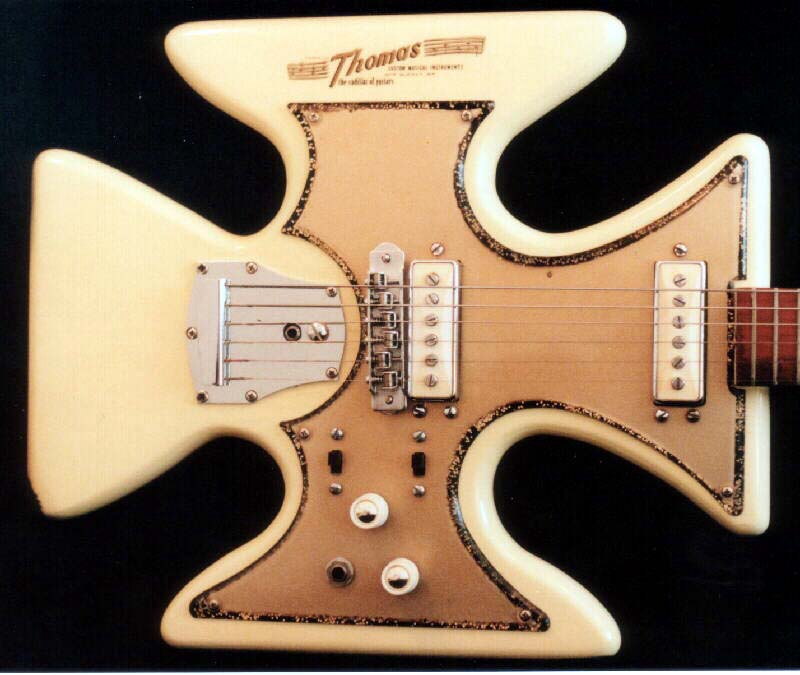

Sorry this such a long post but you don't come across this kind of stuff every day.
Davib ib Bartheloba wid a dold... Atchoo!
Guitarz - The Original Guitar Blog - now in its 10th year!
Labels:
fibre glass,
innovations,
Thomas Guitars,
vintage guitars
Wednesday, 16 February 2011
1964 Welson Super Jazz
guitarz.blogspot.com:
I think the seller is being a little bit lazy referring to the 1964 Welson Super Jazz as a "Jaguar", as whilst it does indeed look rather "surfy", it doesn't resemble a Jaguar that much. And wouldn't "Jazzmaster have been more relevant, if equally untrue? I love the switches with the "Jazz" labelling - "Jazz Tones", "Jazz - Super Jazz"... I can no more imagine a jazz guitarist playing this than I can Michael Angelo Batio playing the banjolele. (I suppose some clever dick is going to point out that he does play the ukulele... I wonder if it has five necks arranged in a star formation and rotates?).
It's a pity this Super Jazz doesn't have a similar "interesting" vinyl finish as on this Welson bass.
Currently for sale on eBay with a starting price of £895, which despite the guitar's rarity might be a tad optimistic.
G L Wilson
Guitarz - The Original Guitar Blog - now in its 10th year!
I think the seller is being a little bit lazy referring to the 1964 Welson Super Jazz as a "Jaguar", as whilst it does indeed look rather "surfy", it doesn't resemble a Jaguar that much. And wouldn't "Jazzmaster have been more relevant, if equally untrue? I love the switches with the "Jazz" labelling - "Jazz Tones", "Jazz - Super Jazz"... I can no more imagine a jazz guitarist playing this than I can Michael Angelo Batio playing the banjolele. (I suppose some clever dick is going to point out that he does play the ukulele... I wonder if it has five necks arranged in a star formation and rotates?).
It's a pity this Super Jazz doesn't have a similar "interesting" vinyl finish as on this Welson bass.
Currently for sale on eBay with a starting price of £895, which despite the guitar's rarity might be a tad optimistic.
G L Wilson
Guitarz - The Original Guitar Blog - now in its 10th year!
Tuesday, 15 February 2011
Jack Daniels bass
guitarz.blogspot.com:
Well, there's not much that can be said about this Jack Daniels bass - obviously inspired by the one used by Michael Anthony - other than that it'd be perfect for your Van Halen tribute band! It's a fun piece, a bit of a rock'n'roll cliché perhaps, but it's been very nicely executed. However, the Buy It Now price of $1,900 does seem a little steep for a nameless piece such as this (handmade in the UK, apparently - by who we are not told) and way out of the price range of most people working in covers bands.
G L Wilson
Guitarz - The Original Guitar Blog - now in its 10th year!
Well, there's not much that can be said about this Jack Daniels bass - obviously inspired by the one used by Michael Anthony - other than that it'd be perfect for your Van Halen tribute band! It's a fun piece, a bit of a rock'n'roll cliché perhaps, but it's been very nicely executed. However, the Buy It Now price of $1,900 does seem a little steep for a nameless piece such as this (handmade in the UK, apparently - by who we are not told) and way out of the price range of most people working in covers bands.
G L Wilson
Guitarz - The Original Guitar Blog - now in its 10th year!
Danelectro Longhorn Baritone Reissue
This Danelectro Longhorn Baritone is a guitar about which I can honestly tell: 'I love it', because I do own one and each time I put my fingers on it I feel that it was a good move to get it!
Of course it has the characteristics of Danelectros - super light toy-like body made of masonite, non-versatile lipstick pickups, minimal gear and electronics, but what it does, it does perfectly, its sound is unique, its unusual shape happens to be quite ergonomic, and its extreme 760 mm scale (metric system, yeah) gives it a deep and twangy voice.
This one is a 2007 reissue, a limited edition in mate black finish that you won't find easily already nowadays. Sometimes I think that I should have bought 5 - it's also quite a cheap guitar - because I'm not sure I will find it ever again and I will want to play it always (for my next show I will play a Jacques Brel song in the style of Angelo Badalamenti, and it sounds wicked on the Longhorn)...
Bertram
Guitarz - The Original Guitar Blog - now in its 10th year!
Of course it has the characteristics of Danelectros - super light toy-like body made of masonite, non-versatile lipstick pickups, minimal gear and electronics, but what it does, it does perfectly, its sound is unique, its unusual shape happens to be quite ergonomic, and its extreme 760 mm scale (metric system, yeah) gives it a deep and twangy voice.
This one is a 2007 reissue, a limited edition in mate black finish that you won't find easily already nowadays. Sometimes I think that I should have bought 5 - it's also quite a cheap guitar - because I'm not sure I will find it ever again and I will want to play it always (for my next show I will play a Jacques Brel song in the style of Angelo Badalamenti, and it sounds wicked on the Longhorn)...
Bertram
Guitarz - The Original Guitar Blog - now in its 10th year!
PJ Harvey plays an Airline
Yesterday evening, PJ Harvey was playing her brand new album live in Paris, and this was also on arte.tv. Not only Polly-Jean is one the most talented artist of her generation, but she has very good taste when it comes to guitars.
This time she traded her usual Firebird or Gretsch Broadkaster for a 3 pickup Airline, thought I cannot tell from the picture if it's an original model or an Eastwood reissue - the last version of it with the rubber band around the body - and I couldn't find anything about this on the Web...
EDIT: thanks to our readers, I can tell now that it's an original Airline - the Eastwood has a black truss-rod cover on the headstock, and a wide tune-o-matic bridge...
EDIT: thanks to our readers, I can tell now that it's an original Airline - the Eastwood has a black truss-rod cover on the headstock, and a wide tune-o-matic bridge...
Bertram
Guitarz - The Original Guitar Blog - now in its 10th year!
Monday, 14 February 2011
Hondo II Iceman rough copy
guitarz.blogspot.com:
Despite the glowing write-ups in certain eBay listings that I've seen, Hondo guitars have a dreadful reputation, and I've heard many an ex-owner complain that they were cheap and nasty - and often unplayable - copies. Judging by this Hondo copy of an Ibanez Iceman, they weren't very accurate copies either. Look at the shape of that thing - that curvy lower is slightly reminiscent of a Musicvox Spaceranger. I'm also aware of the irony of an Ibanez Iceman copy, when before the Iceman, Ibanez were copyists themselves.
So, any Hondo owners or ex-owners out there? Were they really all that bad?
G L Wilson
Guitarz - The Original Guitar Blog - now in its 10th year!
Despite the glowing write-ups in certain eBay listings that I've seen, Hondo guitars have a dreadful reputation, and I've heard many an ex-owner complain that they were cheap and nasty - and often unplayable - copies. Judging by this Hondo copy of an Ibanez Iceman, they weren't very accurate copies either. Look at the shape of that thing - that curvy lower is slightly reminiscent of a Musicvox Spaceranger. I'm also aware of the irony of an Ibanez Iceman copy, when before the Iceman, Ibanez were copyists themselves.
So, any Hondo owners or ex-owners out there? Were they really all that bad?
G L Wilson
Guitarz - The Original Guitar Blog - now in its 10th year!
Vintage Hofner archtop acoustic
guitarz.blogspot.com:
This vintage Hofner archtop acoustic caught my eye on eBay. Despite asking a Buy It Now price of $1,500, the seller offers no information about it other than it's "All Original, never modded." Hhhhhmmmm, for that kind of money I think I'd want a bridge. But anyway, I digress. Does anyone out there know the model? And is that a third soundhole or is it a diamond-shaped label?
G L Wilson
Guitarz - The Original Guitar Blog - now in its 10th year!
This vintage Hofner archtop acoustic caught my eye on eBay. Despite asking a Buy It Now price of $1,500, the seller offers no information about it other than it's "All Original, never modded." Hhhhhmmmm, for that kind of money I think I'd want a bridge. But anyway, I digress. Does anyone out there know the model? And is that a third soundhole or is it a diamond-shaped label?
G L Wilson
Guitarz - The Original Guitar Blog - now in its 10th year!
Sunday, 13 February 2011
Burns/Hayman prototype hybrid guitar
guitarz.blogspot.com:
Am I the only one who thinks that modern electro acoustics and and hybrid guitars look just too sterile? I really never did like this business of hiding away all the gubbins. "Oh, you can't have any visible pickups or control knobs, that'll spoil the illusion of this being an acoustic guitar." Huh! As if those horrible little slider controls they stick on the rim of an electro acoustic are any kind of replacement!
I've always liked acoustics that have obviously been electrified with pickups and control knobs on show for all to see. They can have a rather Heath Robinson appeal sometimes (Oh, if only Heath Robinson had designed a guitar!), but to me they seem all the more honest, as if to say, "Yes, this is an acoustic but it's hardly unplugged!"
Think John Lennon with his Gibson J-160E, Nirvana's Kurt Cobain playing supposedly "unplugged" with a Martin D-18E, or John Martyn with a Martin guitar with pickups obviously gaffer-taped to the guitar creating loops on an Echoplex machine (as if an acoustic could do that without all the electrickery!).
So... the above pictured one-off Burns/Hayman prototype is a guitar that I find mightily appealing. It's an acoustic/electric hybrid guitar that proudly displays its electric components for all to see. I like the electric style compensated bridge set into an acoustic style "moustache" - that's a nice touch. Actually, I doubt that acoustically this guitar is very loud at all - looking at the picture of the back of the guitar (I'll put some more photos in the comments) it does appear to have a very shallow body. It's like they took the Burns Steer guitar, and made it a little bit more acoustic-y.
I don't really have much info on this guitar other than what the eBay seller tells us (hey, it is a rarity), so let's quote from the listing:
G L Wilson
Guitarz - The Original Guitar Blog - now in its 10th year!
Am I the only one who thinks that modern electro acoustics and and hybrid guitars look just too sterile? I really never did like this business of hiding away all the gubbins. "Oh, you can't have any visible pickups or control knobs, that'll spoil the illusion of this being an acoustic guitar." Huh! As if those horrible little slider controls they stick on the rim of an electro acoustic are any kind of replacement!
I've always liked acoustics that have obviously been electrified with pickups and control knobs on show for all to see. They can have a rather Heath Robinson appeal sometimes (Oh, if only Heath Robinson had designed a guitar!), but to me they seem all the more honest, as if to say, "Yes, this is an acoustic but it's hardly unplugged!"
Think John Lennon with his Gibson J-160E, Nirvana's Kurt Cobain playing supposedly "unplugged" with a Martin D-18E, or John Martyn with a Martin guitar with pickups obviously gaffer-taped to the guitar creating loops on an Echoplex machine (as if an acoustic could do that without all the electrickery!).
So... the above pictured one-off Burns/Hayman prototype is a guitar that I find mightily appealing. It's an acoustic/electric hybrid guitar that proudly displays its electric components for all to see. I like the electric style compensated bridge set into an acoustic style "moustache" - that's a nice touch. Actually, I doubt that acoustically this guitar is very loud at all - looking at the picture of the back of the guitar (I'll put some more photos in the comments) it does appear to have a very shallow body. It's like they took the Burns Steer guitar, and made it a little bit more acoustic-y.
I don't really have much info on this guitar other than what the eBay seller tells us (hey, it is a rarity), so let's quote from the listing:
Rare Virginian hybrid guitar designed by Barry Gibson and Keith West of Burns London Ltd. featuring:I'm actually surprised it's as recent as that; it looks older. Anyway, it has a starting price of £249 on it and a But It Now price of £850.
A real collectors piece for Burns/Hayman fans 1 only made as this model was never put into production. The guitar was made over 12 years ago in the U.K. and has been sitting in the Burns warehouse since then, untouched.
- Burns Rezo-Matik pick-ups
- Solid Spruce Top
- Rosewood back and sides
- Burns badged Gotoh tuners
- Burns Tortoiseshell bridge section
G L Wilson
Guitarz - The Original Guitar Blog - now in its 10th year!
Saturday, 12 February 2011
Ergo Instruments Custom handmade 'Cloud' guitar
guitarz.blogspot.com:
Built by Ergo Instruments who normally specialize in electric upright basses, this custom-made 'Cloud' guitar doesn't rigourously follow the specs of those used by Prince (different scale-length, different pickups, natural burst finish instead of opaque, etc), and should be considered a tribute guitar rather than a painstakingly accurate replica. In my view it looks all the better for it. Also, for a handmade guitar, the Buy It Now price of $999 is very appealing - I've seen the scary prices attached to other 'Cloud guitars!
G L Wilson
Guitarz - The Original Guitar Blog - now in its 10th year!
Built by Ergo Instruments who normally specialize in electric upright basses, this custom-made 'Cloud' guitar doesn't rigourously follow the specs of those used by Prince (different scale-length, different pickups, natural burst finish instead of opaque, etc), and should be considered a tribute guitar rather than a painstakingly accurate replica. In my view it looks all the better for it. Also, for a handmade guitar, the Buy It Now price of $999 is very appealing - I've seen the scary prices attached to other 'Cloud guitars!
G L Wilson
Guitarz - The Original Guitar Blog - now in its 10th year!
Friday, 11 February 2011
Interesting 'slide' technique with fingers!
This is Ronnie from Botswama who has a really interesting playing technique! I'll let the video do the talking, just click "play" already!
Thanks to Marty Jensen for recommending this clip.
Thanks also to Paul Bob for pointing me in the direction of a better quality version of the video than the one I posted pre-edit.
G L Wilson
Guitarz - The Original Guitar Blog - now in its 10th year!
Thanks to Marty Jensen for recommending this clip.
Thanks also to Paul Bob for pointing me in the direction of a better quality version of the video than the one I posted pre-edit.
G L Wilson
Guitarz - The Original Guitar Blog - now in its 10th year!
Califone-branded Murph Squire XII from 1966
guitarz.blogspot.com:
We've previously looked at a California-made Murph Squire 12-string back in December 2009. Murph guitars don't come up on eBay all too often, but the above-pictured example - currently for sale on eBay with a Buy It Now price of $1650 - is even rarer as it carries the "Califone" brandname and is effectively a prototype. To borrow from the eBay listing:
Guitarz - The Original Guitar Blog - now in its 10th year!
We've previously looked at a California-made Murph Squire 12-string back in December 2009. Murph guitars don't come up on eBay all too often, but the above-pictured example - currently for sale on eBay with a Buy It Now price of $1650 - is even rarer as it carries the "Califone" brandname and is effectively a prototype. To borrow from the eBay listing:
G L WilsonCalifone guitars were made for Rheem Califone (the record player people) in Los Angeles to complement their range of school PA equipment. In mid 1966 Murphy Music was approached by Califone (also located in San Fernando) to build a range of guitars and amps (this is how the amp side of the business got started) that they could market to schools to compliment the audio stuff they were providing to the education department - a potential BIG money spinner for MURPH! ...BUT, as seemed to happen a lot with them, the luck of the Irish WASN'T with Pat Murphy with this venture either - Califone had a change of heart and called off the deal after 25 or so prototypes were made. They were made up of 6 strings, basses and 12 string guitars. Most were basic Squires [...] with a changed nameplate but they did do some with ‘slanted’ pickups and different Gumby-like headstocks.
Guitarz - The Original Guitar Blog - now in its 10th year!
Thursday, 10 February 2011
1968 Kimberly Vamper by Teisco
guitarz.blogspot.com:
Next up today, we have another red Japanese guitar, although this one is from two decades before the Kawai Aquarius we looked at earlier.
This 1968 Kimberly/Teisco Vamper would appear to be a rare beastie. As the seller points out:
G L Wilson
Guitarz - The Original Guitar Blog - now in its 10th year!
Next up today, we have another red Japanese guitar, although this one is from two decades before the Kawai Aquarius we looked at earlier.
This 1968 Kimberly/Teisco Vamper would appear to be a rare beastie. As the seller points out:
Aside from a picture on the Teisco Twanger's Paradise site, a few small mentions and queries by persons attempting to discover their value, there's almost no info at all on the 'Net about the Vamper.We looked at another Kimberly guitar in October 2008 - I couldn't find out very much information about that one either!
Basically the same hardware and appointments as its sister instruments, the somewhat more common May Queen and the uber rare Fire Bird. Like her sisters, the Vamper is at least a level or two better quality than most ordinary Teiscos. Great playing guitar!
Semi hollowbody construction with an obvious Mosrite influence. Red/orange finish, almost like Fender Fiesta Red...
G L Wilson
Guitarz - The Original Guitar Blog - now in its 10th year!
Kawai Aquarius in Cellophane Red
guitarz.blogspot.com:
I know that Bertram is a fan of the Kawai Aquarius, but am not too sure if this example with all-over Cellophane Red finish would appeal to him.
We've seen a couple of cellophane red DiMarzio Strats on here before, including one that I own. (We've also looked at a similarly finished Ibanez DT-250 X series). I'm wondering if this Kawai guitar might have been made in the same Harayama factory that supplied the Strat parts to DiMarzio, or could this have been a finish that more than one Japanese manufacturer were specialising in?
G L Wilson
Guitarz - The Original Guitar Blog - now in its 10th year!
I know that Bertram is a fan of the Kawai Aquarius, but am not too sure if this example with all-over Cellophane Red finish would appeal to him.
We've seen a couple of cellophane red DiMarzio Strats on here before, including one that I own. (We've also looked at a similarly finished Ibanez DT-250 X series). I'm wondering if this Kawai guitar might have been made in the same Harayama factory that supplied the Strat parts to DiMarzio, or could this have been a finish that more than one Japanese manufacturer were specialising in?
G L Wilson
Guitarz - The Original Guitar Blog - now in its 10th year!
Wednesday, 9 February 2011
Grace Chang sings the Habanera aria from Georges Bizet's "Carmen"
guitarz.blogspot.com:
Ah, I love it when we get contributions from Guitarz readers (please keep 'em coming!). Here's an email I received earlier today:
G L Wilson
Guitarz - The Original Guitar Blog - now in its 10th year!
Ah, I love it when we get contributions from Guitarz readers (please keep 'em coming!). Here's an email I received earlier today:
Interesting use of a resonator guitarThanks Tone! (Do you mind if I call you Tone?) There's a fun challenge for our readers! I can't say I would have expected to see a National Tri-Cone resonator guitar in the hands of Chinese actress/singer Grace Chang whilst singing an aria from the opera "Carmen". Can anyone beat that for a guitar being used in an unusual context?
Check out this clip of a 1960 Hong Kong movie:
http://www.youtube.com/watch?v=wqI4h1uODng
The girl starts off playing a resonator in a fancy Hong Kong night club while singing Carmen. I'm not asking for an ID of the guitar - I just thought it was an interesting use of a resonator. I wonder if your blog readers can find other "out of place" guitars in films, etc.
cheers,
Tone Deaf Radio
G L Wilson
Guitarz - The Original Guitar Blog - now in its 10th year!
Fender ST-Champ travel Strat with built-in amp
guitarz.blogspot.com:
Although I can imagine one or two readers groaning when they see this blog post, I make no apologies for showing you all yet another Stratocaster. Yes, the Stratocaster does seem to have a certain omnipresence to it, but one of the things I enjoy about it is the sheer number of variations on a theme that we see. Rest assured, I'm not going to blog about a bog-standard Stratocaster - we've all seen those a thousand times and more; if I'm going to blog about a Strat, it's going to be different in some way.
This particular Strat is a Fender Japan ST-Champ and I guess it would be safe to say that it represents Fender's take on the travel guitar. It has a mini-sized body although the neck appears to be full-scale, a single humbucker and an on-board amp. The ST-CHAMP is definitely not to be confused with the 3/4-scale Squier Mini with on-board amp. The difference in quality should be apparent from the photos. Having not seen one of these before, my guess is that this guitar was produced for the Japanese market only. If you know differently, I'm happy to be told otherwise!
Thanks to Keith McCreary who found this guitar on the www.ishibashi.co.jp/eng site.
G L Wilson
Guitarz - The Original Guitar Blog - now in its 10th year!
Although I can imagine one or two readers groaning when they see this blog post, I make no apologies for showing you all yet another Stratocaster. Yes, the Stratocaster does seem to have a certain omnipresence to it, but one of the things I enjoy about it is the sheer number of variations on a theme that we see. Rest assured, I'm not going to blog about a bog-standard Stratocaster - we've all seen those a thousand times and more; if I'm going to blog about a Strat, it's going to be different in some way.
This particular Strat is a Fender Japan ST-Champ and I guess it would be safe to say that it represents Fender's take on the travel guitar. It has a mini-sized body although the neck appears to be full-scale, a single humbucker and an on-board amp. The ST-CHAMP is definitely not to be confused with the 3/4-scale Squier Mini with on-board amp. The difference in quality should be apparent from the photos. Having not seen one of these before, my guess is that this guitar was produced for the Japanese market only. If you know differently, I'm happy to be told otherwise!
Thanks to Keith McCreary who found this guitar on the www.ishibashi.co.jp/eng site.
G L Wilson
Guitarz - The Original Guitar Blog - now in its 10th year!
Tuesday, 8 February 2011
1967 Epiphone Riviera 12-string
I'm also a 12-string guitars lover and this Epiphone Riviera is an extremely lovable one! This is not the first ES-335 12-string we've seen here - there was a Gibson, a Kapa, an Ovation... - but this one in dark natural finish is quite something.
It's been produced in Gibson's factory in Kalamazoo in 1967, at the same time Gibson was selling a similar model, but actually at a cheaper price!
Bertram
Guitarz - The Original Guitar Blog - now in its 10th year!
Lego guitars from Foster's Brothers
guitarz.blogspot.com:
This photo was posted on the Guitarz Facebook page. Clicking through to the Foster's Brothers page, we find out the following info:
G L Wilson
Guitarz - The Original Guitar Blog - now in its 10th year!
This photo was posted on the Guitarz Facebook page. Clicking through to the Foster's Brothers page, we find out the following info:
Foster's Brothers Guitars builds fine, quality instruments. Designer/Builder Keith has been building Lego-bodied guitars for 14 years now. In that time he has completed 13 Lego builds. His build process and the quality of the instrument has significantly increased over that time.They are certainly distinctive-looking instruments and well worthy of a Guitarz blog post. I can't imagine that the body is completely Lego - it'd need some kind of solid core or foundation, I would have thought. Anyway, great, fun designs! Love it!
Keith's designs - whether in Lego, or whatever medium he tackles, ALWAYS push the limits. They are some of the most radical designs out there.
G L Wilson
Guitarz - The Original Guitar Blog - now in its 10th year!
Monday, 7 February 2011
Red Japanese guitar... but what is it exactly?
guitarz.blogspot.com:
I saw this red Japanese guitar on eBay and wasn't too sure of its identity. The seller didn't seem to know either, suggesting it might be a Yamaha, Teisco or Guyatone.
However, I knew I recognised those N-shaped inlays on the fingerboard and was pretty sure we'd blogged about one of these before, and knowing it was going to bug me if I didn't identify the guitar, I started checking through the Guitarz archives.
Luckily I didn't have to search back too far. In fact, it was only February last year that we featured a similar guitar. Yes, it seems we have here another Norma solidbody (although I'm not sure about the exact model designation in this instance). Norma brand guitars were built by the Tombo Instrument company in Japan and imported into the US by Strum & Drum of Chicago. I expect this guitar would date to the latter half of the 1960s.
G L Wilson
Guitarz - The Original Guitar Blog - now in its 10th year!
I saw this red Japanese guitar on eBay and wasn't too sure of its identity. The seller didn't seem to know either, suggesting it might be a Yamaha, Teisco or Guyatone.
However, I knew I recognised those N-shaped inlays on the fingerboard and was pretty sure we'd blogged about one of these before, and knowing it was going to bug me if I didn't identify the guitar, I started checking through the Guitarz archives.
Luckily I didn't have to search back too far. In fact, it was only February last year that we featured a similar guitar. Yes, it seems we have here another Norma solidbody (although I'm not sure about the exact model designation in this instance). Norma brand guitars were built by the Tombo Instrument company in Japan and imported into the US by Strum & Drum of Chicago. I expect this guitar would date to the latter half of the 1960s.
G L Wilson
Guitarz - The Original Guitar Blog - now in its 10th year!
Keith's homemade guitar
guitarz.blogspot.com:
Keith writes:
Great to see the whole build process too!
G L Wilson
Guitarz - The Original Guitar Blog - now in its 10th year!
Keith writes:
I read your blog every time you have a new post and enjoy it very much. I don't know if you are interested in this or not but I've built an electric guitar for myself. I posted the whole process on my blog.Thanks for that, Keith. That's a highly individual-looking guitar you have there! I like the contouring to the top - it's like an extreme German carve. It's so nice to see a guitar that someone's created that isn't a "cookie cutter" guitar using the same old templates that we see time and time again, or else looks as if it's been made by someone who has never even seen an electric guitar before and just had someone not very knowledgeable describe one to them.
Great to see the whole build process too!
G L Wilson
Guitarz - The Original Guitar Blog - now in its 10th year!
Sunday, 6 February 2011
Sad News: Gary Moore passes away
guitarz.blogspot.com:
This news, as untimely as it is, comes as a great shock.
As reported in The Irish Times:
More at: http://www.irishtimes.com/newspaper/breaking/2011/0206/breaking25.html
I know that Moore was happy to have put his rock years behind him and to have reinvented himself as a blues guitarist, but I'll always have a soft spot for his "Back On The Streets" album. I also loved his work with Thin Lizzy on the "Black Rose" album.
Very sad.
G L Wilson
Guitarz - The Original Guitar Blog - now in its 10th year!
This news, as untimely as it is, comes as a great shock.
As reported in The Irish Times:
Former Thin Lizzy guitarist Gary Moore has died at a Costa del Sol hotel.
The musician was found dead in his room at the luxury Kempinski Resort Hotel in Estepona in the early hours of this morning. A postmortem is due to carried out later today in the nearby city of Malaga.
Moore (58) from Belfast is understood to have been on holiday at the time of his death.
More at: http://www.irishtimes.com/newspaper/breaking/2011/0206/breaking25.html
I know that Moore was happy to have put his rock years behind him and to have reinvented himself as a blues guitarist, but I'll always have a soft spot for his "Back On The Streets" album. I also loved his work with Thin Lizzy on the "Black Rose" album.
Very sad.
G L Wilson
Guitarz - The Original Guitar Blog - now in its 10th year!
Ted Crocker Six Banger
guitarz.blogspot.com:
It seems ages ago that I blogged about Ted Crocker, maker of cigar box guitars, rustic guitars, Stonehenge pickups and The Honeydripper guitar from the film of the same name. Here we see the Ted Crocker Six Banger guitar, designed in conjunction with guitarist Shane Speal to be a "blues axes with late 1940s/early 1950s charm".
Excuse me while I borrow from the guitar's listing on eBay:
Currently for sale on eBay with a Buy It Now price of $650.
G L Wilson
Guitarz - The Original Guitar Blog - now in its 10th year!
It seems ages ago that I blogged about Ted Crocker, maker of cigar box guitars, rustic guitars, Stonehenge pickups and The Honeydripper guitar from the film of the same name. Here we see the Ted Crocker Six Banger guitar, designed in conjunction with guitarist Shane Speal to be a "blues axes with late 1940s/early 1950s charm".
Excuse me while I borrow from the guitar's listing on eBay:
- Solid mahogany body with absolutely gorgeous grain (see pictures of the back for stunning woodgrain).
- Hand rubbed linseed oil finish. 8 coats.
- Wraparound Les Paul Jr. type tailpiece for increased sustain.
- Underwound handmade pickup in the neck position for a more snarling slide tone. We compared outputs of Harmony Stratotone pickups when designing this. Our goal was to get a tone meaner than Hound Dog Taylor!
- Bolt-on neck that has been carefully stained and aged.
- Leather covered headstock with Ted Crocker's signature branded into the leather. The headstock cutaway matches the body cutaway.
- Handmade wood knobs.
- Medium action - perfect for fretting or slide playing.
Currently for sale on eBay with a Buy It Now price of $650.
G L Wilson
Guitarz - The Original Guitar Blog - now in its 10th year!
Saturday, 5 February 2011
1974 Framus Electric Mandolin
I'm tripping on electric mandolins lately, as I want to expand my music and really enjoy what Warren Ellis does with Grinderman (he doesn't play only his signature tenor guitar).
This 1974 8-string Framus Electric Mandolin in Black Rose finish could fulfill my dreams and my birthday is soon (my anti-GAS no-more-guitar policy doesn't apply here, it's a mandolin)...
Bertram
Guitarz - The Original Guitar Blog - now in its 10th year!
Friday, 4 February 2011
Charles H. Kaman, inventor of the Ovation Guitar dies at age 91
guitarz.blogspot.com:
Charles H. Kaman - aviation pioneer in the development of helicopters and the creator of the Ovation Roundback guitar - has died in Connecticut USA [on Monday January 31].
In the 1940s he split off from Sikorsky Aviation to found his own corporation to design and manufacture helicopter blades. Using the knowledge he had regarding the control of vibrations, he set out in the mid-1960s to create a new type of guitar: using a strong molded one-piece parabolic assembly of sides and back made out of the same fiberglass compound he used on his blades. In-store demonstrations of the earliest Ovation guitars were a sight to behold: the sales rep would put the guitar face-down on the floor and stand on the bowl assembly.
Kaman (sounds like "command") was among the first to use alternative synthetic materials on guitars, paving the way for Steinberger and others. Kaman was 91.
Via Alan Peterson
(See also the New York Times obituary)
Guitarz - The Original Guitar Blog - now in its 10th year!
Charles H. Kaman - aviation pioneer in the development of helicopters and the creator of the Ovation Roundback guitar - has died in Connecticut USA [on Monday January 31].
In the 1940s he split off from Sikorsky Aviation to found his own corporation to design and manufacture helicopter blades. Using the knowledge he had regarding the control of vibrations, he set out in the mid-1960s to create a new type of guitar: using a strong molded one-piece parabolic assembly of sides and back made out of the same fiberglass compound he used on his blades. In-store demonstrations of the earliest Ovation guitars were a sight to behold: the sales rep would put the guitar face-down on the floor and stand on the bowl assembly.
Kaman (sounds like "command") was among the first to use alternative synthetic materials on guitars, paving the way for Steinberger and others. Kaman was 91.
Via Alan Peterson
(See also the New York Times obituary)
Guitarz - The Original Guitar Blog - now in its 10th year!
1953 Gretsch Clipper
Didn't know that Gretsch could produce a summary guitar?
Here is the Gretsch Clipper, a budget guitar from the 50s - the name was prolonged later for more sophisticated models - with one DeArmond Dynasonic (or probably a Fidelatone as they were first called) pickup, no cutaway, no pickguard, no sunburst, no fancy inlays or stoptail...
Bertram
Guitarz - The Original Guitar Blog - now in its 10th year!
Vintage Hoyer Telething
Tried hard but couldn't find anything about this bizarro Hoyer Tele-like guitar - actually it's maybe a one-off or a Frankenstein but it looks quite real - the control plate at least I saw or other (later) Hoyers - they have been releasing Tele inspired guitars for ever - still do.
The pickups feel really Japanese 60s products, the 3/3 big headstock is so out of place that it's attractive, the Silvertone-esque pickguard is pretty cool - I'm quite intrigued by this guitar, anybody knows more?
Bertram
Guitarz - The Original Guitar Blog - now in its 10th year!
Thursday, 3 February 2011
1960s Yamaha SB2A bass
guitarz.blogspot.com:
This is an orginal Yamaha SBV bass from the late 1960s, although I'm not entirely sure of the exact model designation of this single-pickup version. (Edit: Big Red X tells me that it's an SB2A). Back in May of last year we looked at Kevin's pair of Yamaha SBV basses, which were re-issues from circa 2000. Other than pickup layout, the main difference between these and the 1960s example pictured above is scale length - this is apparent from the position of the bridge. Speaking of the bridge, there is no way that Precision-style unit is original to the 1960s SBV (and a quick Google image search will confirm this). The string spacing is a fraction too wide: look at how close the G and E strings come to the edge of the fingerboard up at the top end of the neck as it gets closer to the body.
Currently being offered for sale on eBay with a starting price of £449.
G L Wilson
Guitarz - The Original Guitar Blog - now in its 10th year!
This is an orginal Yamaha SBV bass from the late 1960s, although I'm not entirely sure of the exact model designation of this single-pickup version. (Edit: Big Red X tells me that it's an SB2A). Back in May of last year we looked at Kevin's pair of Yamaha SBV basses, which were re-issues from circa 2000. Other than pickup layout, the main difference between these and the 1960s example pictured above is scale length - this is apparent from the position of the bridge. Speaking of the bridge, there is no way that Precision-style unit is original to the 1960s SBV (and a quick Google image search will confirm this). The string spacing is a fraction too wide: look at how close the G and E strings come to the edge of the fingerboard up at the top end of the neck as it gets closer to the body.
Currently being offered for sale on eBay with a starting price of £449.
G L Wilson
Guitarz - The Original Guitar Blog - now in its 10th year!
1947 Gretsch Electromatic Spanish Electric Guitar
guitarz.blogspot.com:
This surprisingly well preserved Gretsch Electromatic currently gracing eBay is quite a beauty. It has some remarkable features but the most unusual, for me, are the machine heads. We showed a Modulus Genesis G3 a while back that had compensated tuners to keep the strings in a straight line and this appears to be an earlier attempt at the same idea. I think this is what's known as an "engineering solution".
I'll let the sellers describe the rest:

This surprisingly well preserved Gretsch Electromatic currently gracing eBay is quite a beauty. It has some remarkable features but the most unusual, for me, are the machine heads. We showed a Modulus Genesis G3 a while back that had compensated tuners to keep the strings in a straight line and this appears to be an earlier attempt at the same idea. I think this is what's known as an "engineering solution".
I'll let the sellers describe the rest:
This is for a 1947 Gretsch Electromatic Hollow-body Spanish Electric Guitar. This terrific guitar looks great! The top and back of the body do not have any cracks or chips in them. The right side of the body has two screws driven into, one right next to the neck and the other right next to the top binding between the upper and lower bouts; the screw between the bouts appears to have a couple of very small cracks extending about 1/8" away from it kinda parallel to the binding, but the other screw does not have any cracks involved with it. The top, back, and sides all show a few dings and indentions in them as well as a few very light surface scratches - none of which is through the lacquer to the bare wood. The inside of the body appears to be a bit dirty and some of the wiring is not original. However, the pickup and potentiometers do appear to be original.
The output jack is loose and needs to be re-attached and the knobs are missing on the front. The neck and headstock both show similar surface scratches and indentions as those found on the body, but are also free of cracks and chips. The tuners on the headstock are also original. The fretboard has a some noticeable spots of what appears to be dried glue on it, plus the frets show some fairly heavy wear, but are still playable. The action on this guitar is about medium-high and it plays well and sounds wonderful. This amazing guitar features a scale of 25-1/2", a 1-11/16" nut width, a 19-fret (14-fret accessibility) rosewood fretboard, and a Gretsch tailpiece.
I'm not 100% convinced that the tailpiece is original, personally.
David - Slacking in Barcelona
Guitarz - The Original Guitar Blog - now in its 10th year!
Wednesday, 2 February 2011
Fender Electric XII
guitarz.blogspot.com:
Even those who've only been reading this blog for just a couple of months will have noticed that I have a soft spot for electric 12-strings. Here is one of the classics, the Fender Electric XII, introduced in 1965 and remaining in production for five years. The body design owes a lot to the Jazzmaster and Jaguar guitars, and the headstock is an over-sized hockey-stick shape - I can only assume so as to have somewhere prominent to display the Fender logo! (I have a Fender Strat XII and the Fender logo is somewhat lost in the middle of the small headstock that guitar has. You can imagine what an aggressive Marketing Department might think of that!)
The Electric XII was supposedly designed from the ground up to be a 12-string guitar, rather than being an adaptation of an existing 6-string guitar design. It's funny that in more recent years Fender have resorted to issusing the 12-string Stratocaster instead of this beauty. However, I'm sure the Custom Shop would knock one up for someone willing to throw the right amount of money in their direction.
The distinctive-looking split pickups are selected via a 4-way switch offering settings for neck, neck and bridge in series, neck and bridge in parallel and bridge only options.
It's funny, everyone thinks of the Gibson doubleneck as being the "Stairway to Heaven" guitar, but on the recorded version on "Led Zeppelin 4" (or "Four Symbols" if you will!) it was a Fender Electric XII that Jimmy Page used for the 12-string parts. The guitar has also been used by, amongst others, Lou Reed, Jeff Beck, Pete Townshend and Bob Dylan (pictured right).
See here also for a rare left-handed version. (Well, I'd never seen one before!)
The above-pictured black example is a refurbished Electric XII and is currently being offered for sale on eBay with a Buy It Now price of £1,850.
G L Wilson
Guitarz - The Original Guitar Blog - now in its 10th year!
Even those who've only been reading this blog for just a couple of months will have noticed that I have a soft spot for electric 12-strings. Here is one of the classics, the Fender Electric XII, introduced in 1965 and remaining in production for five years. The body design owes a lot to the Jazzmaster and Jaguar guitars, and the headstock is an over-sized hockey-stick shape - I can only assume so as to have somewhere prominent to display the Fender logo! (I have a Fender Strat XII and the Fender logo is somewhat lost in the middle of the small headstock that guitar has. You can imagine what an aggressive Marketing Department might think of that!)
The Electric XII was supposedly designed from the ground up to be a 12-string guitar, rather than being an adaptation of an existing 6-string guitar design. It's funny that in more recent years Fender have resorted to issusing the 12-string Stratocaster instead of this beauty. However, I'm sure the Custom Shop would knock one up for someone willing to throw the right amount of money in their direction.
The distinctive-looking split pickups are selected via a 4-way switch offering settings for neck, neck and bridge in series, neck and bridge in parallel and bridge only options.
It's funny, everyone thinks of the Gibson doubleneck as being the "Stairway to Heaven" guitar, but on the recorded version on "Led Zeppelin 4" (or "Four Symbols" if you will!) it was a Fender Electric XII that Jimmy Page used for the 12-string parts. The guitar has also been used by, amongst others, Lou Reed, Jeff Beck, Pete Townshend and Bob Dylan (pictured right).
See here also for a rare left-handed version. (Well, I'd never seen one before!)
The above-pictured black example is a refurbished Electric XII and is currently being offered for sale on eBay with a Buy It Now price of £1,850.
G L Wilson
Guitarz - The Original Guitar Blog - now in its 10th year!
Subscribe to:
Comments (Atom)

